-
Posts
4,814 -
Joined
-
Last visited
Content Type
Profiles
Forums
Gallery
Events
Posts posted by gjdale
-
-
Lots of pictures for this update, so I'll spread it over two posts.
The Castings – Painting the Details (continued)
I’d been struggling with getting a satisfactory finish on the “wooden” castings, so I posted some pics to the SWSM forum for review/critique/further advice. Here is a selection of crates I posted.
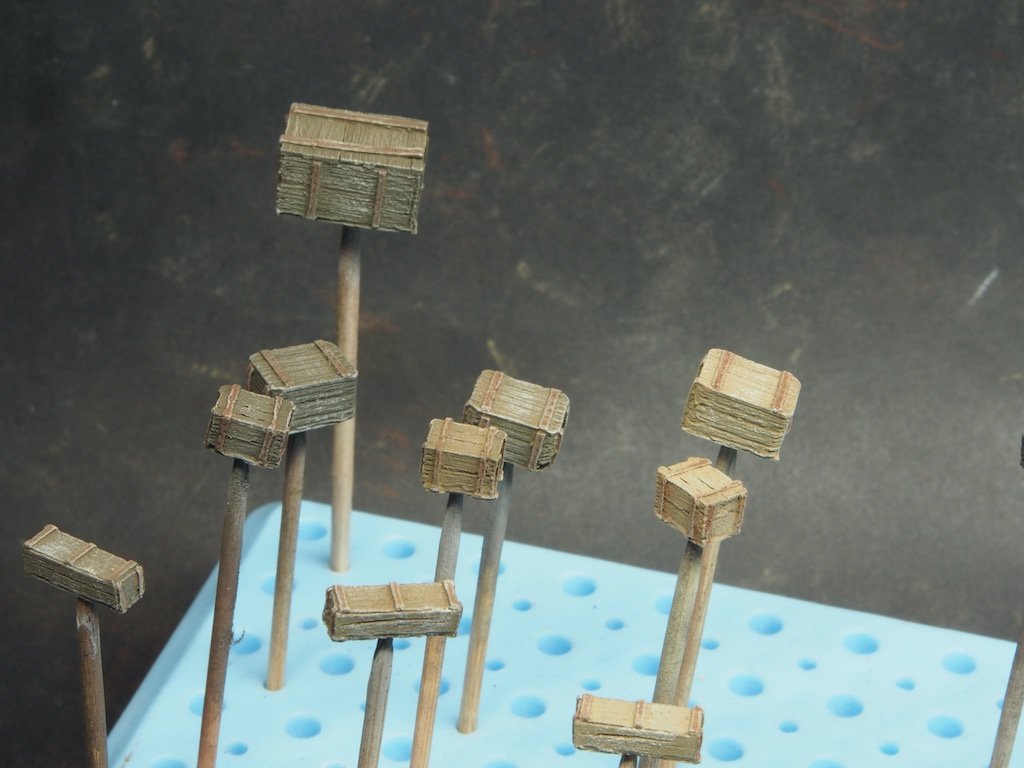
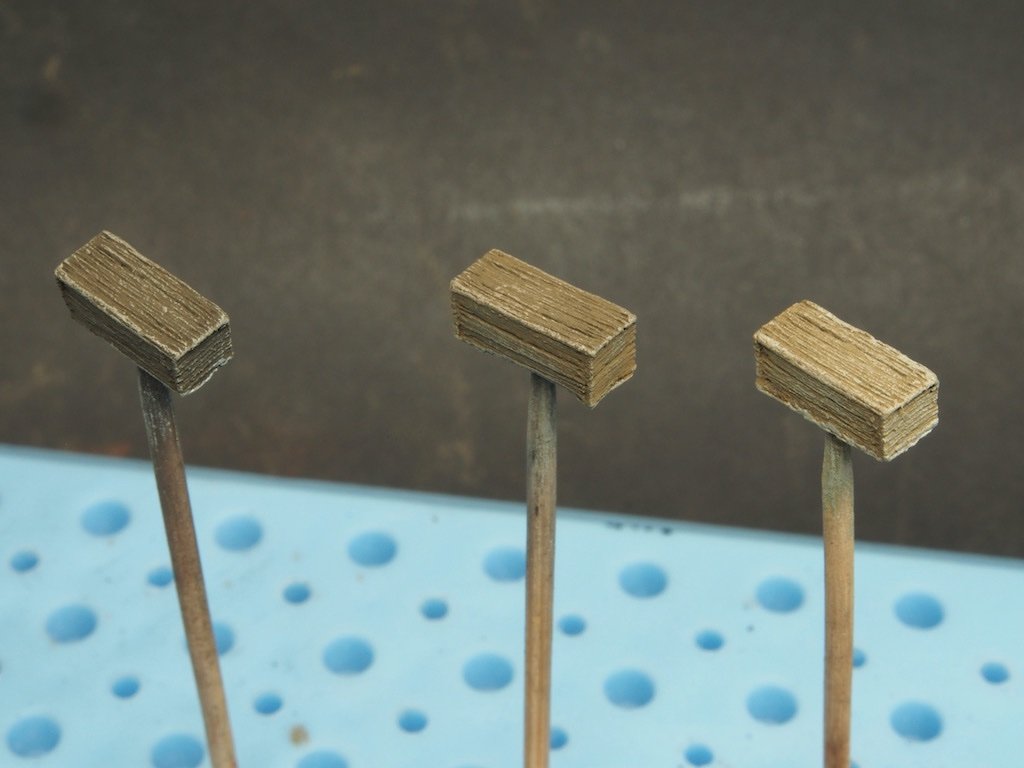
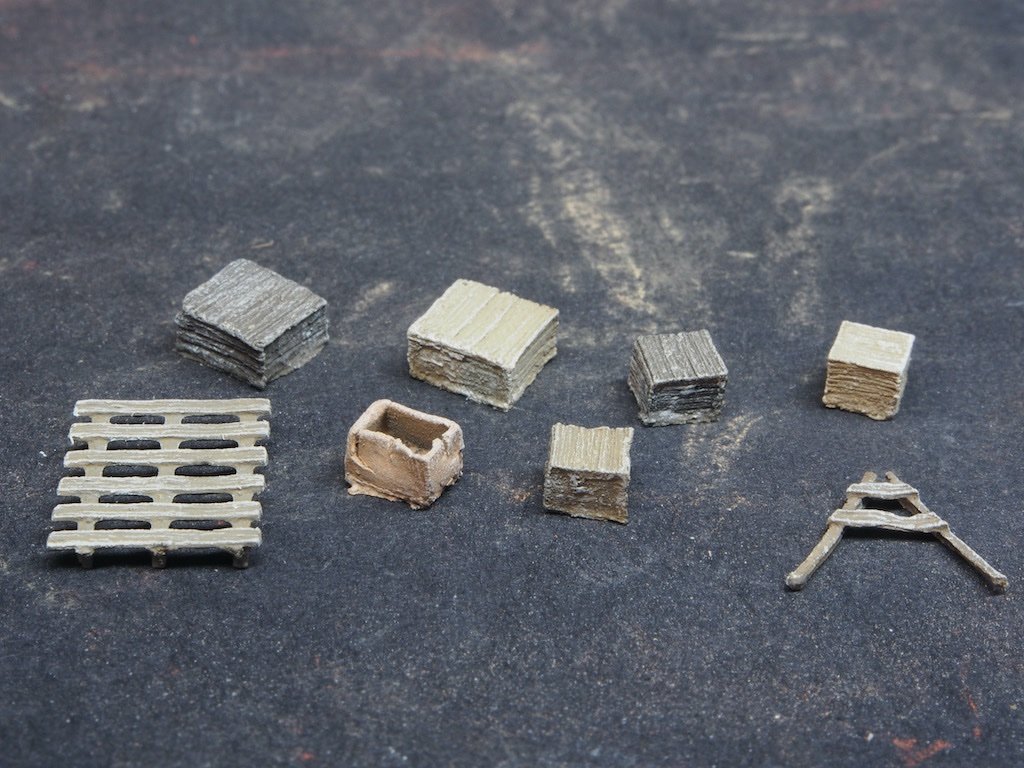
Having received some encouraging feedback from the SWSM Forum, I felt confident to continue with painting of the details.
I have tried where possible to use some of the techniques explained in a couple of discussion threads on the SWSM forum. We begin with a couple of multi-detailed castings. Here is the workbench top (legs/frame to be added later). This is a single casting, packed with details. I’ve included half of a toothpick in the foreground as a reminder of the scale. Parts were picked out in individual colours and then some edges were highlighted by dry brushing. A little dry chalk powder was added where necessary to dirty things up a little.
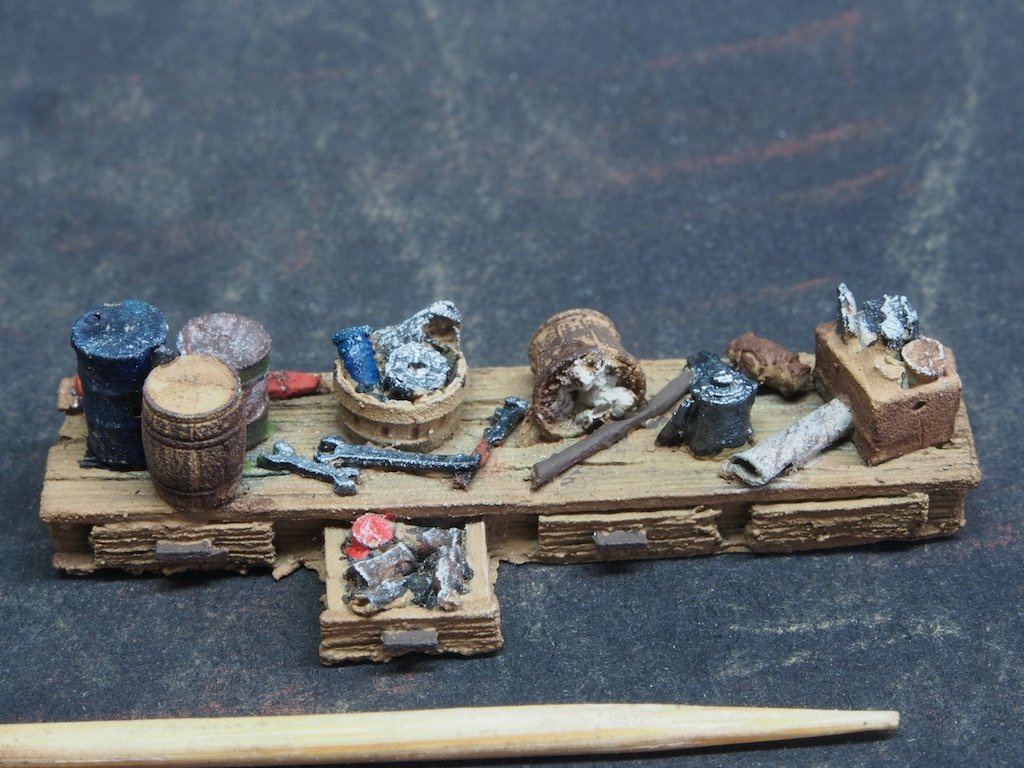
And here is a cupboard/bookcase, again packed with details. The same techniques were used here.
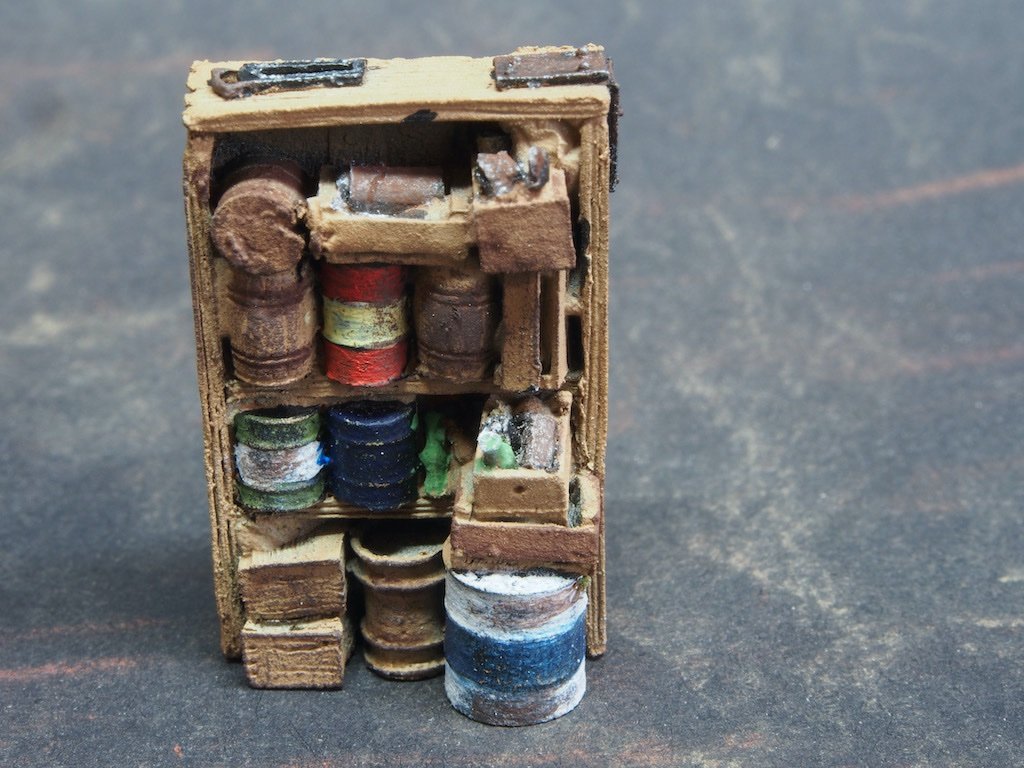
There are a few bins and barrels with the contents cast into them as well.
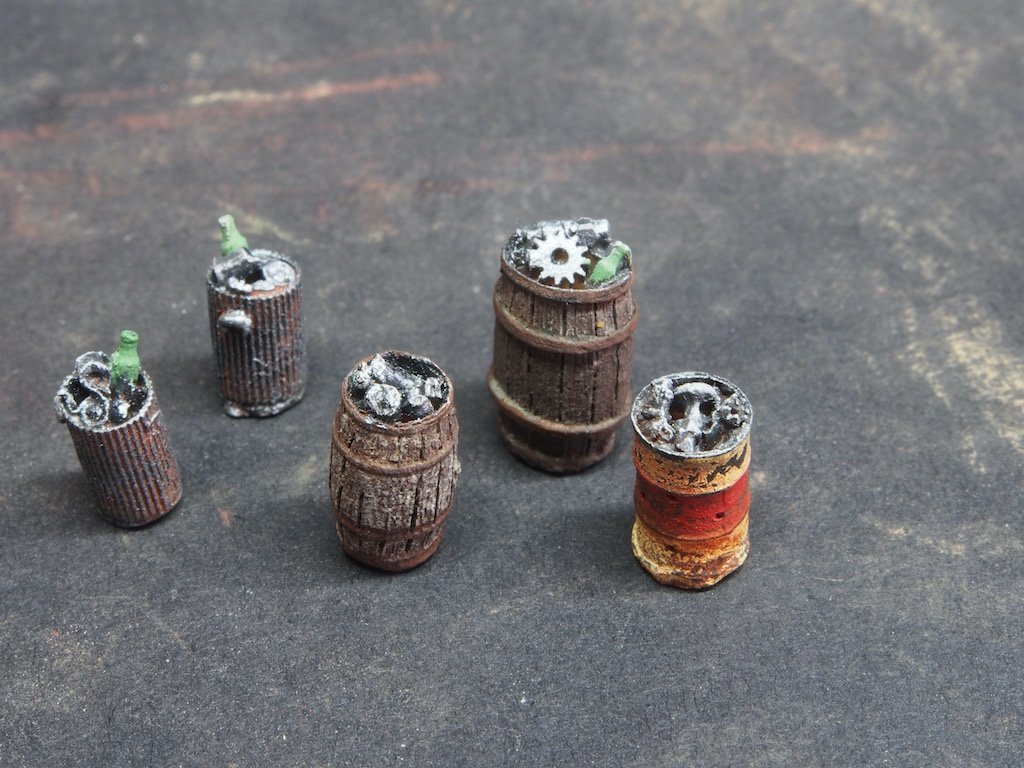
Some miscellaneous larger machinery items – I’m not exactly sure what they are, but figured green was a safe bet for colour. I’ve used a different shade of green on each.
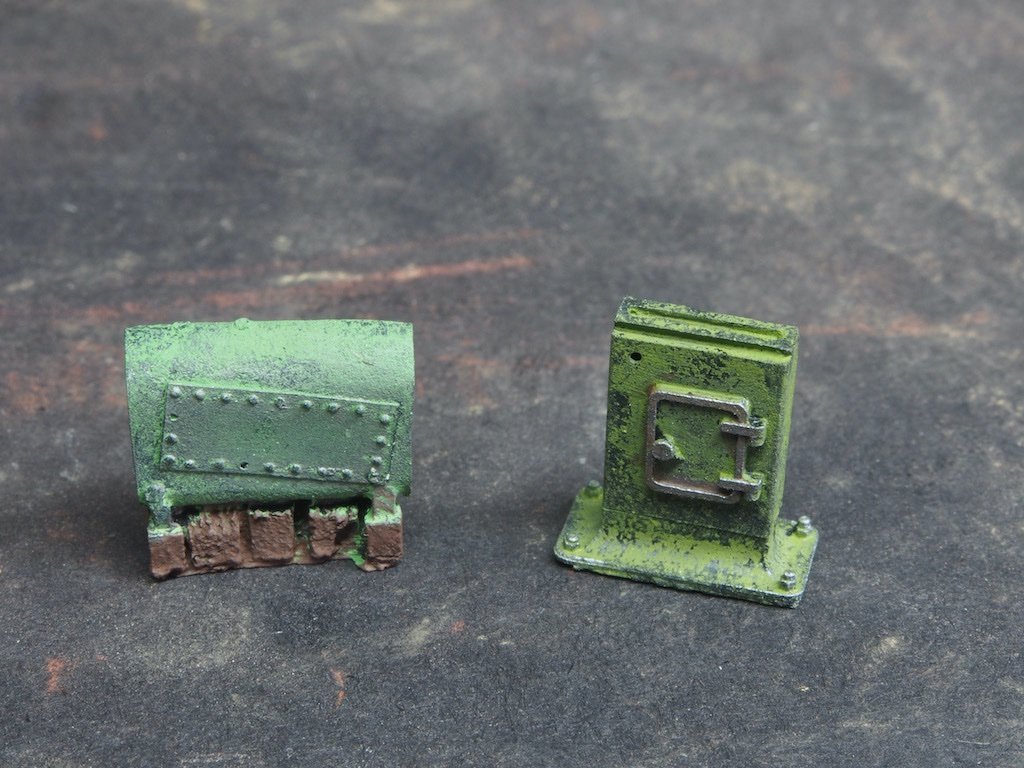
Then there are the plethora of individually cast hand tools. These are all cast white metal parts. The metal areas of the tools are left the buffed blackened colour and are then dry brushed to provide some highlights. Subsequent to this photo, I’ve changed some of the wooden tool handles from brown to a peeling red paint.
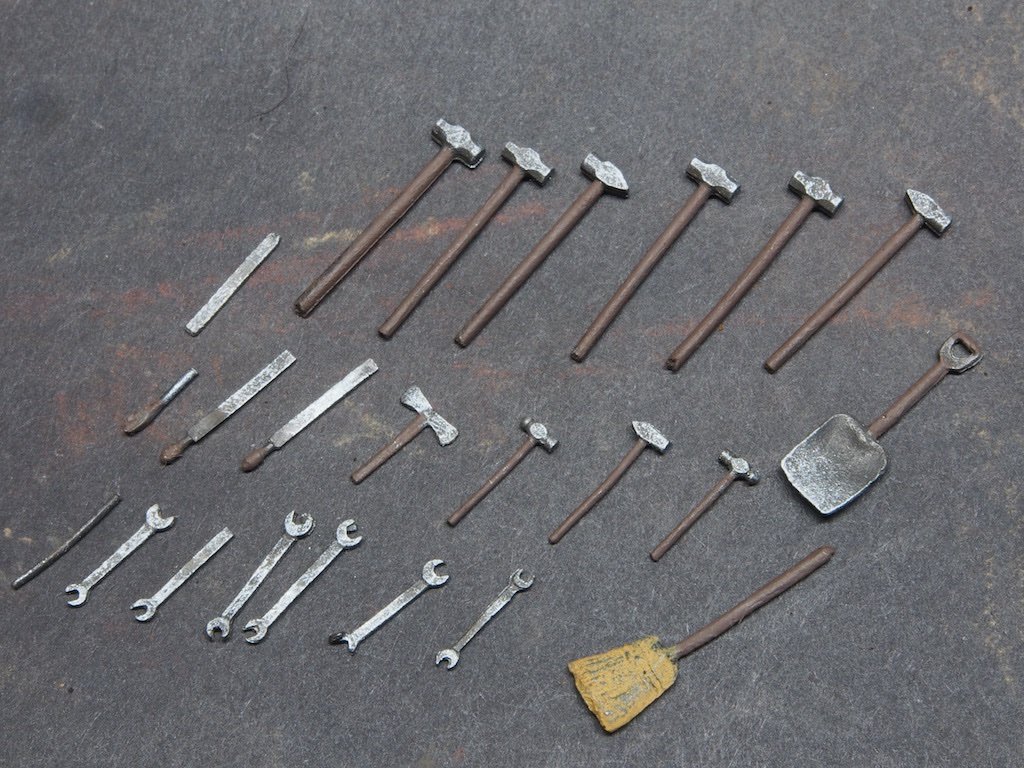
The handcart below is comprised of a resin cast tray, some metal cast wheels placed on a brass rod axle, and some wooden handles made from some scrap strip wood.
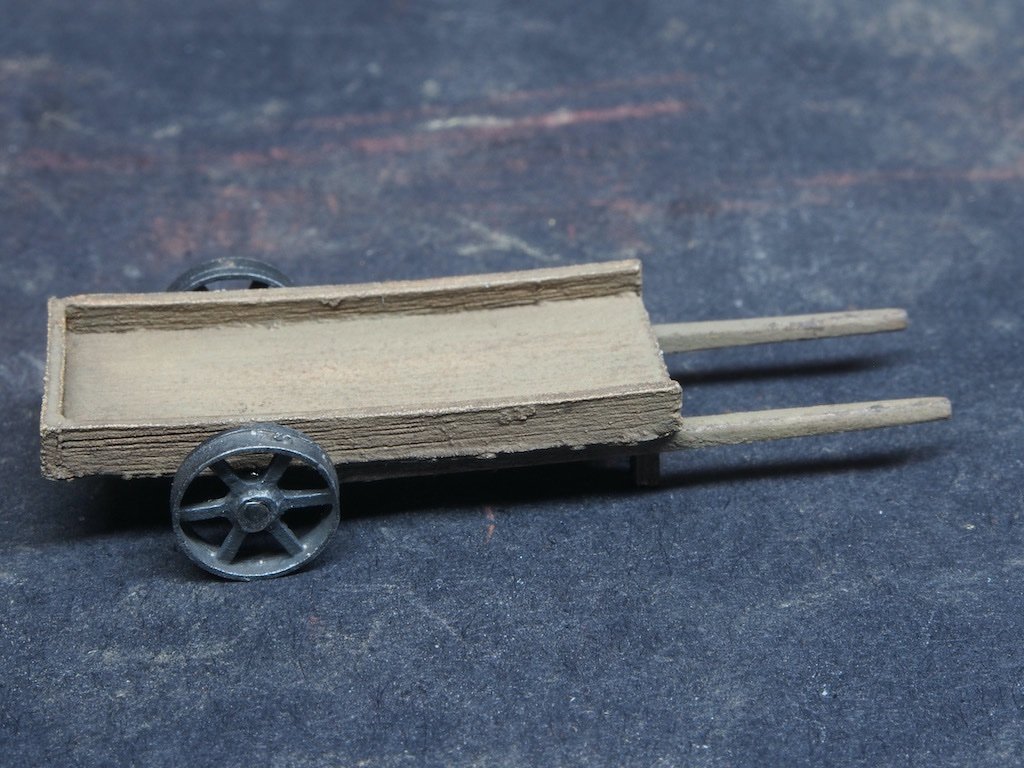
Continued next post...
-
I didn’t buy the front axle - I don’t think it’s necessary. I did buy the steering wheel - expensive, but sooooo nice! I also bought a number of the low cost items like spark plug boots and ignition wires. Also the decal set (well worth it). None of them are essential, it’s up to what you think will improve the appearance of your model versus how much you are prepared to spend. It’s easy to get carried away!
-
-
52 minutes ago, CDW said:
Very interested in the instructions with photos.
The kit instructions are little more than a series of exploded view diagrams. Paul Koo’s instructions take you step by step in a logical sequence and also explain how to do things, as well as giving you a heads-up around some fit issues and how to resolve them. He sells a series of instructional CDs for all of the Pocher kits and the CD contains the written instructions, hundreds of instructional photos of the kit being built, and a stack of reference photos of the real cars. They are a very worthwhile investment.
PS There’s a link in my signature block to my build of this kit. You may find that helpful too.
-
Great to see another of these fantastic models being built. I’m sure that you are aware of some of the fit “issues” with these. If you haven’t already come across him, Paul Koo has produced an excellent set of supplementary instructions that address all of these, along with hundreds of photographs to accompany the “how to” aspects. He also sells replacement parts at very reasonable prices - whatever you are missing, the chances are that Paul will have them. Here’s a link to his eBay store:
https://www.ebay.com/str/pocher-philes-forum
You can also contact him directly. He is very helpful and easy to deal with. I could not have completed my own version of this kit without Paul’s instructions and replacement parts.
Model Motorcars (https://www.modelmotorcars.com/useful-info/favorite-links/) is another great source for “upgraded” parts, but beware - they are not inexpensive, and they are addictive!
I look forward to following along with your build.
-
Thanks Ron - that’s a very nice completed diorama. I hope mine turns out as nicely. I should have a minor update to post this weekend.
-
Congratulations Rusty - a beautiful model, just as we have come to expect from you. It’s been a real pleasure following your build.
- FrankWouts, Rustyj and Dave_E
-
 3
3
-
-
Congratulations on finishing a truly fine build Dave - just superb!
- mtaylor and Knocklouder
-
 2
2
-
-
8 hours ago, BobG said:
Well, not really, Grant. I think I must be getting dense in my advancing age!!
4 hours ago, Brucealanevans said:I agree. Can’t get my head around it.
Thanks Egilman for chiming in here - that is exactly correct. But here are some photos, just in case.
Take a felt polishing wheel for a Dremel-type tool.
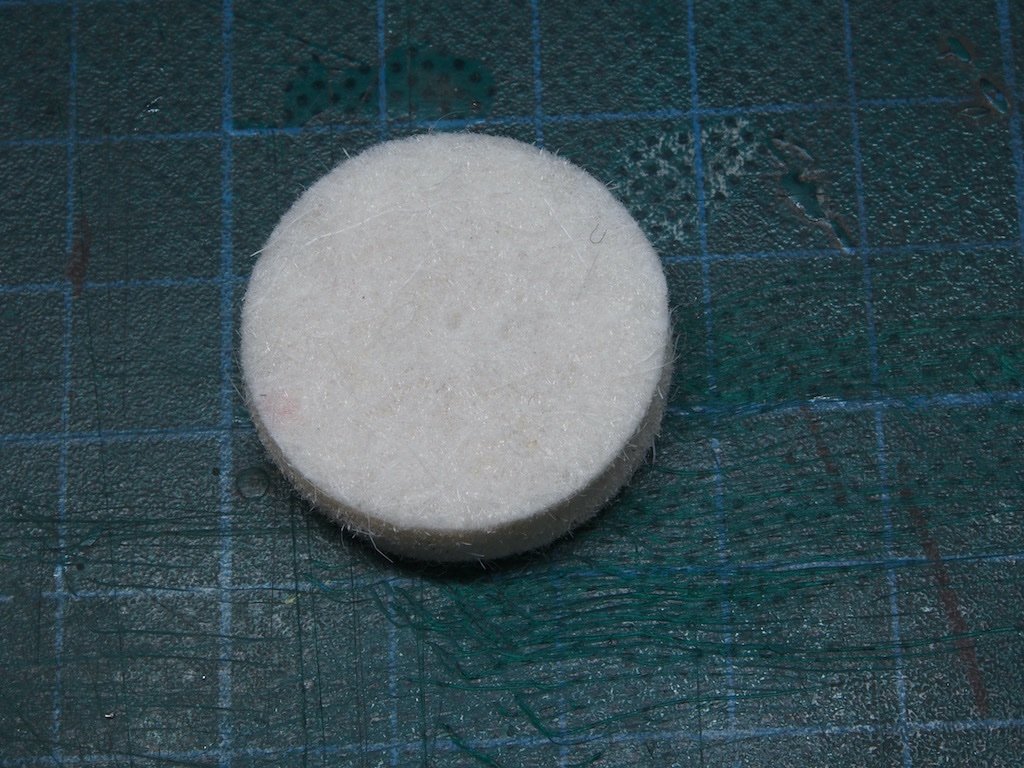
Use a single edge razor blade to cut it in half.
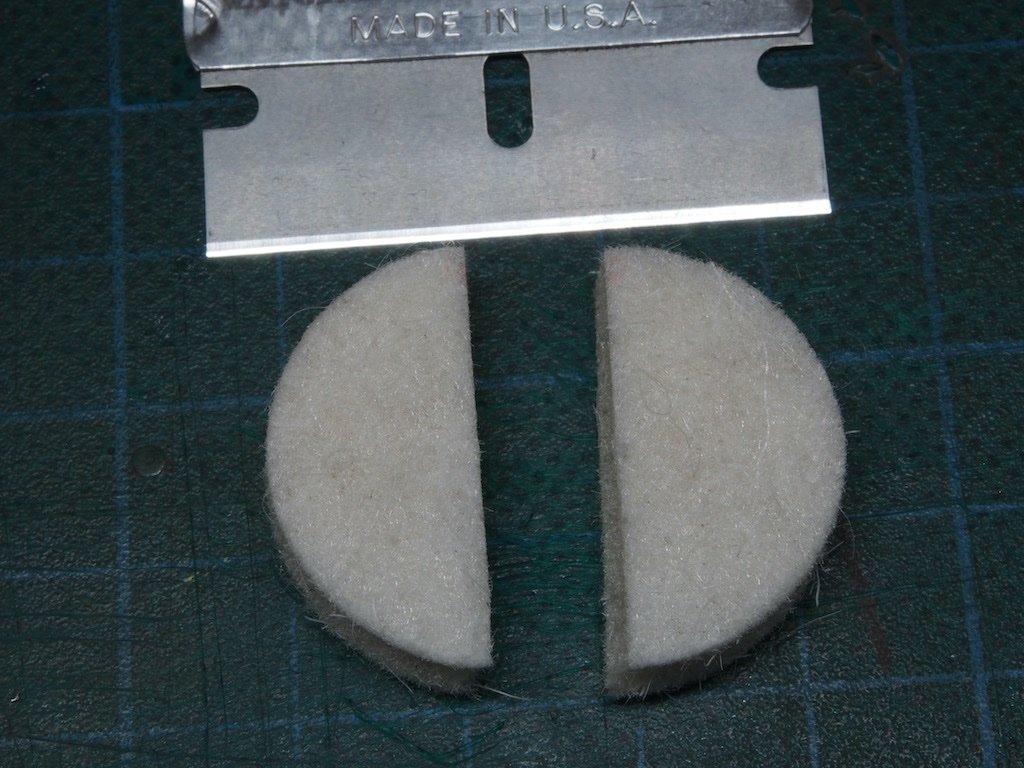
Now use the semi-circular piece to polish the metal casting BY HAND. These parts were way to small and fragile to go anywhere near a spinning tool. You could attach a handle to it if you wished, as Egilman suggested, but I just held the felt in my fingers.
Moving right along...
The Castings – Painting the Details
There is an excellent video tutorial on the Sierra West Scale Models website that demonstrates an extremely easy, yet highly effective technique for achieving peeling and chipped paint effects on the castings. In summary, Once the base coat of black has been allowed to dry thoroughly (in my case it was left for a couple of days), colour is applied using a selection of AK paint colours, and while still wet the part is dunked in Isopropyl Alcohol (IPA) and then dabbed with a make-up sponge to randomly remove bits of paint. It is left to dry for at least a couple of hours, and then the process repeated if there is a second colour to be added. Once that has also dried thoroughly, the parts are dusted with various rust-coloured chalk powders and given another dunk and swirl in IPA to remove most but not all of the chalk, and left to dry again. That’s it – process complete. Here are some of the resin cast oil drums – I have yet to paint the details of the contents of the one in the centre at the back.
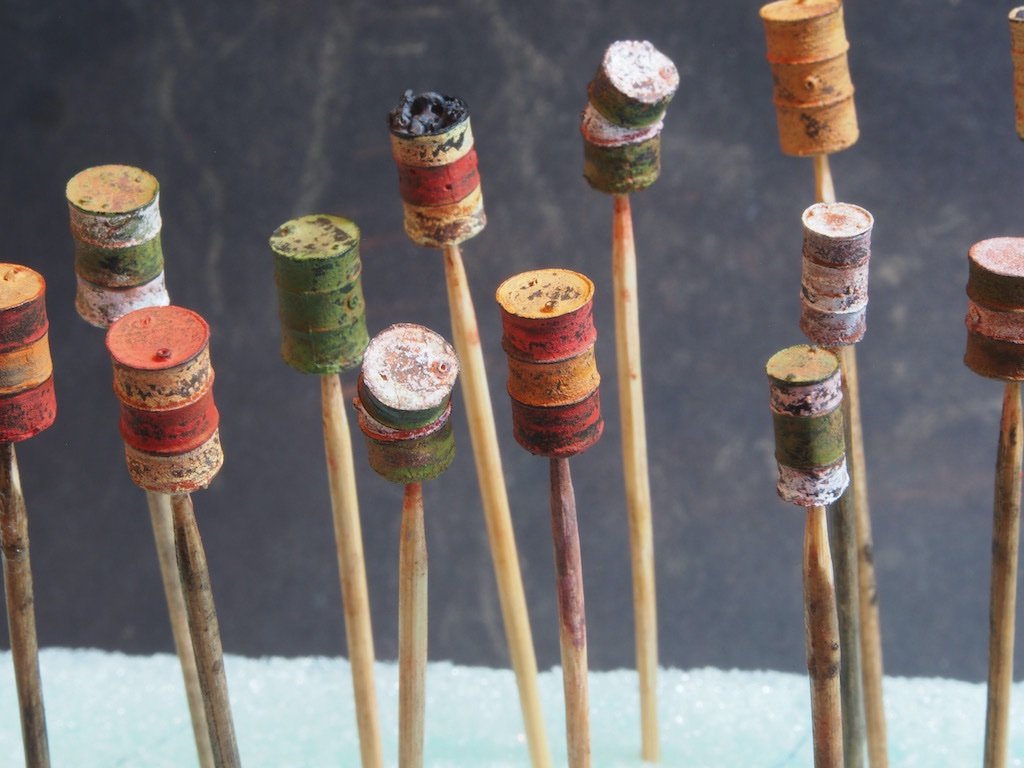
The process works equally well on the metal castings of the Acetylene Tanks.
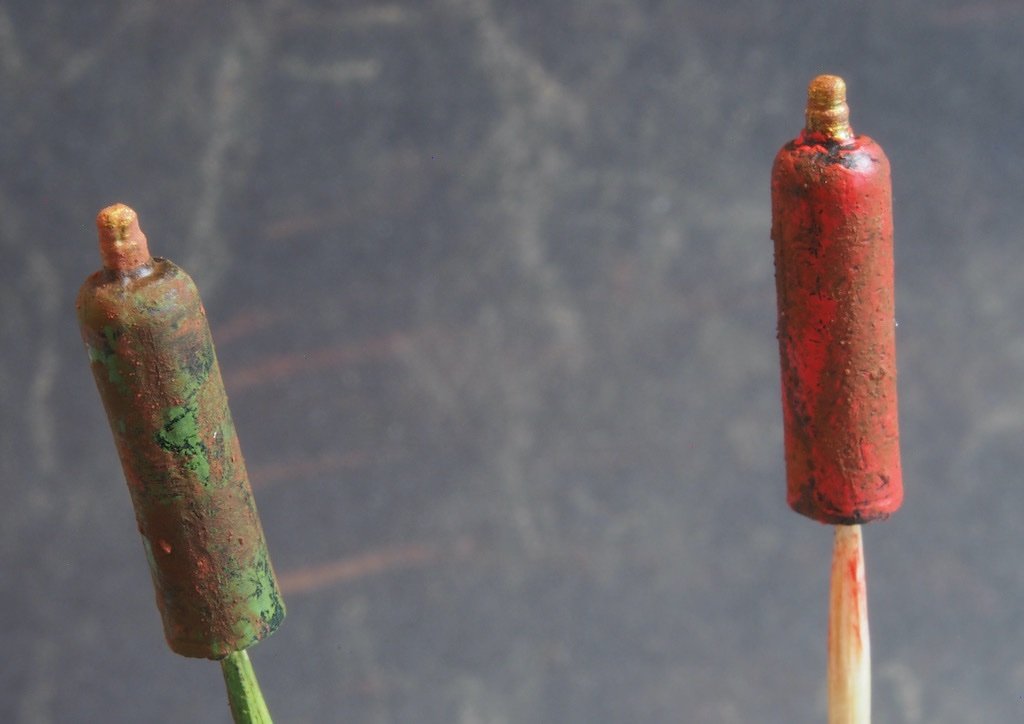
Back to painting wooden crates……..
-
Thanks Bob,
To answer your question, it gives you a semi-circular shape which simply gives you more options on which part of the felt to use. If you need a sharp corner to get into a crevice, then you have one, as well as both a straight section and a rounded section. No photo to hand, but I think you can get the idea?
- Egilman, Keith Black, FriedClams and 5 others
-
 8
8
-
-
The Boiler
With all the castings now having their initial preparation complete, it was time to turn attention back to completion of the Boiler for the Steam Box. The boiler itself is a resin casting, but it has a white metal casting Stack Cap and Valve, along with a brass wire Stack Wire. The boiler was painted with AK 11212 (Gun Metal) and then dry brushed with AK 11210 (Natural Steel) before the blackened and buffed metal parts were epoxied in place.
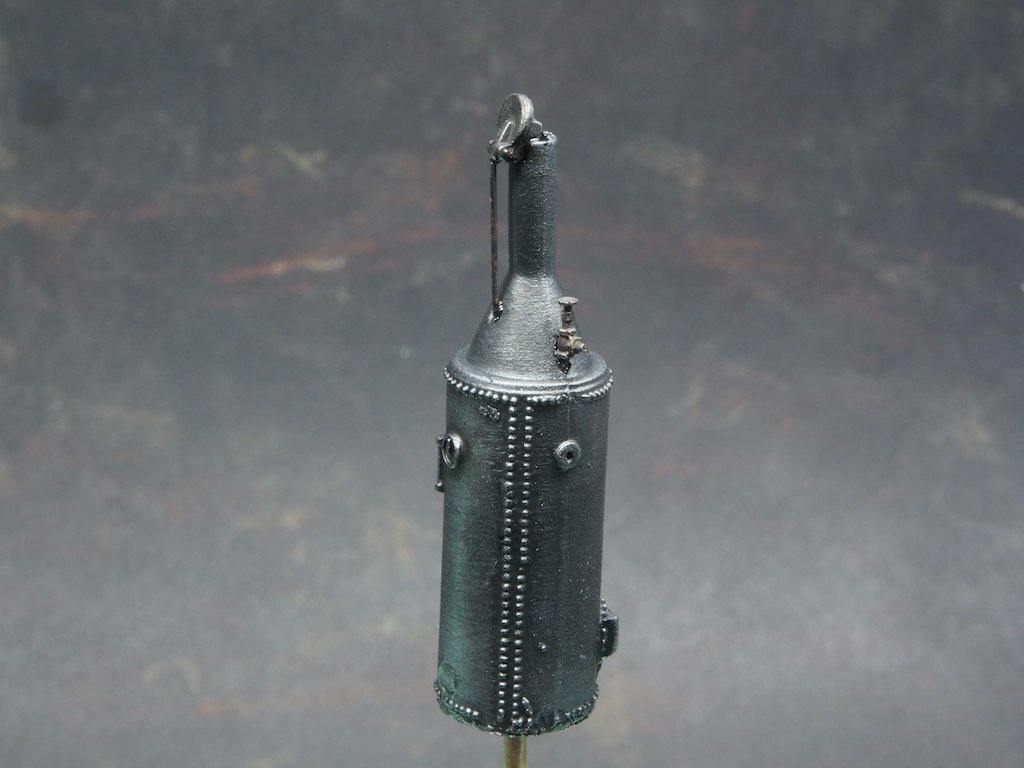
The boiler is mounted on a wooden sled – another resin casting. This was first painted with AK11008 (Grimy Grey) and then dry brushed with AK11110 (Leather Brown). A couple of the tiny hand tools had their handles painted - AK11095 (Dirty Red) for the large wrench, and AK11110(Leather Brown) for the wooden handle of the hammer. In the photo below, you can see part of the toothpick that the sled is mounted on for painting.
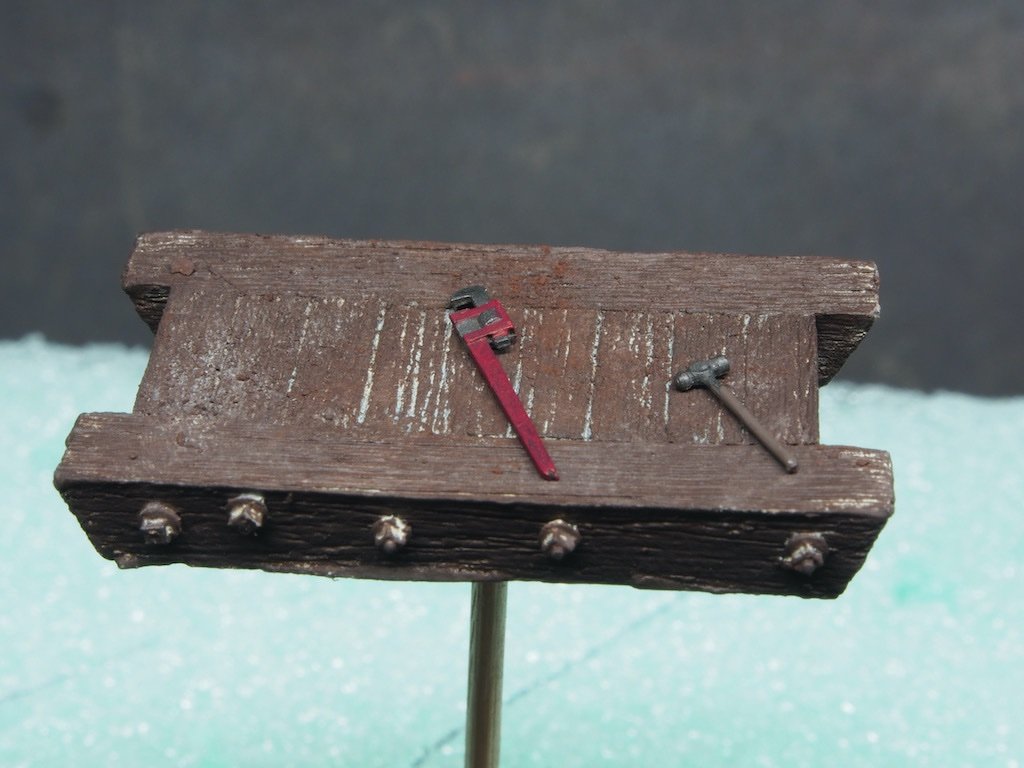
Two barrels are given the same treatment as the sled (again mounted on toothpicks here).
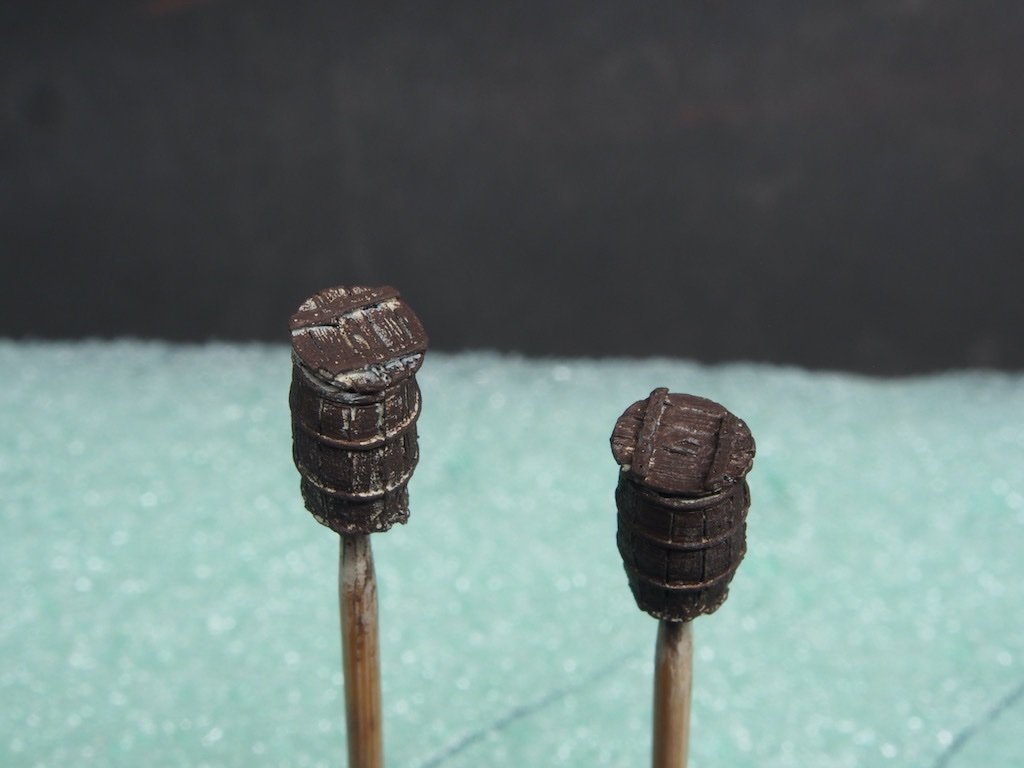
A Steam Hose is then made from a three-inch length of 1.2mm diameter solder. It is painted with AK11147 (Olive Green) and one end is then wrapped in masking tape to simulate the lagging. It was then dirtied up with light dusting of (dry) black and grey chalk powders.
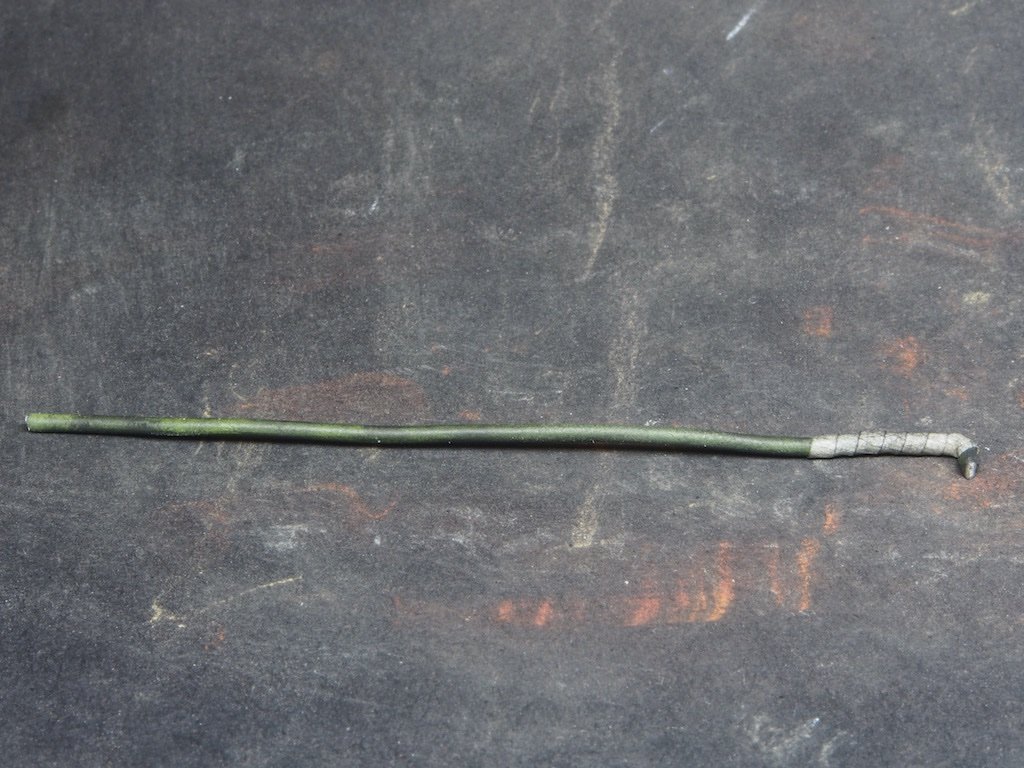
The boiler was then epoxied in place on the sled and four “supports” were made from paper, painted with AK11210 (Natural Steel) and then dusted with some (dry) rust coloured chalk powder. The barrels were then epoxied in place and once dry the feed-water pipe was made from some 0.5mm diameter brass wire, blackened and buffed, and epoxied in place between the barrel and the valve on the boiler. The two hand tools were then epoxied in place, and finally the steam hose was epoxied in place on the side of the boiler.
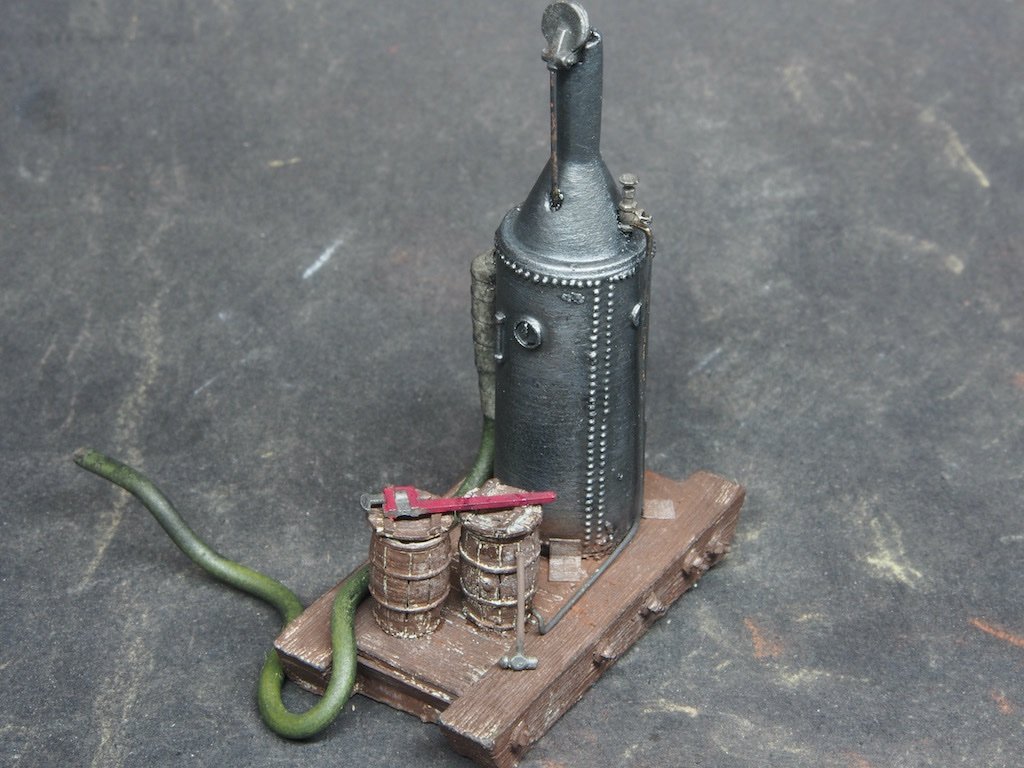
Here it is with the steam hose temporarily attached to the steam box.
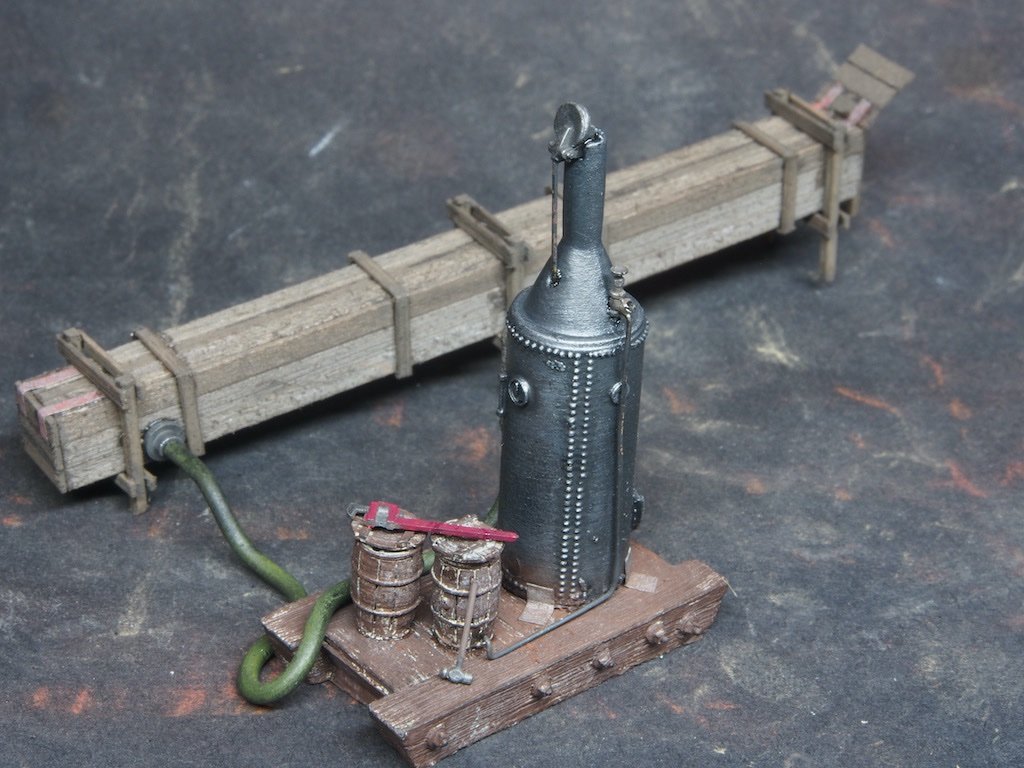
Finally, here it is temporarily in place on the diorama. I had to play with some post-processing adjustments on the photo as the original was very dark. More details will be added to this scene later.
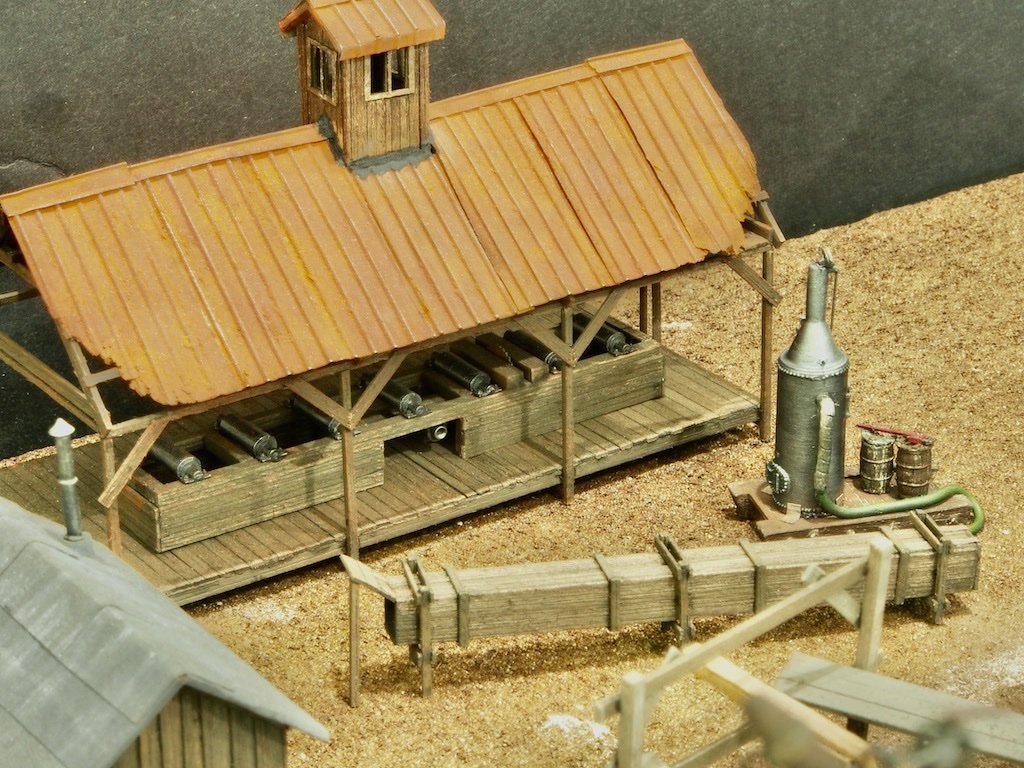
Now it’s back to painting all of those casting detail. This could take a while….
-
The Castings
There are a great many castings included in this kit, in a mixture of white metal and resin. They all need preparation, so I decided that now was as good a time as any to do the initial preparation. Along the way I decided to count them… Including the few castings that are already in place, there are a total of 174 white metal castings and 147 resin castings.
Here is a shot of the remaining white metal castings prior to being “processed”. Some of these parts are extremely small, especially the hand tools!
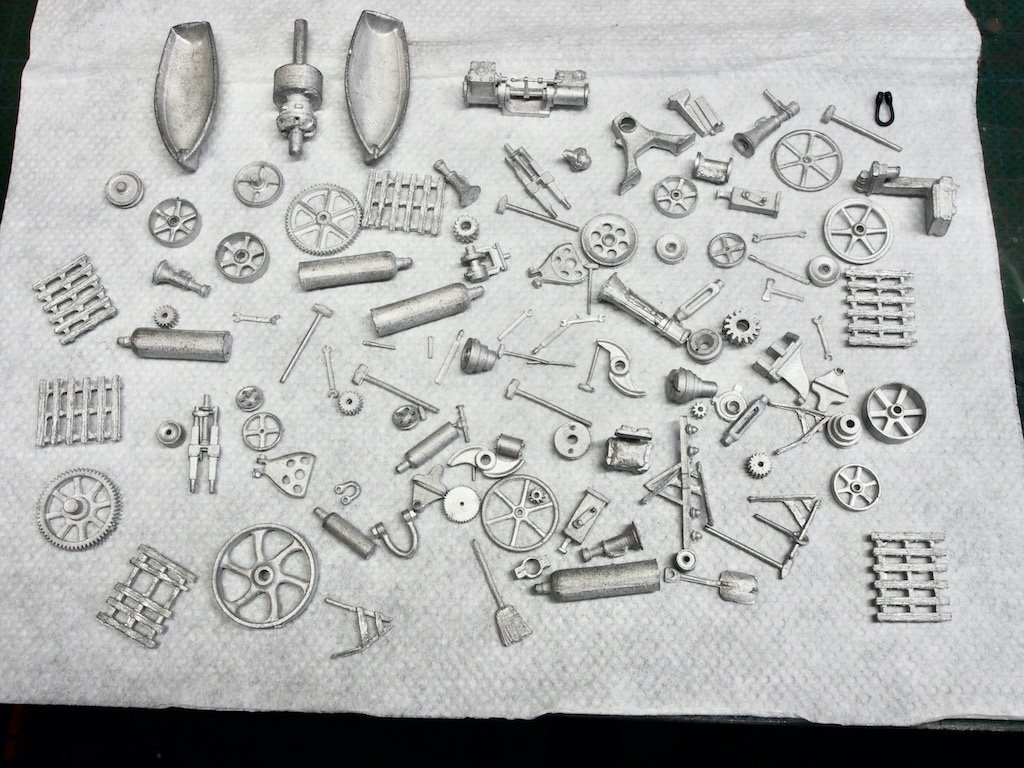
My “process” for the preparation of these parts is to first wash them all in slightly soapy water, then rinse. Next up is an Acetone bath, after which they are not handled by bare hands again. A quick rinse in distilled water, then a 20-minute soak in Vinegar. Another rinse off in distilled water then left to dry before application of Jax’s Pewter Black, applied by scrubbing the part with an old paint brush. Once the part is totally blackened it is dipped in distilled water again and then left to dry. Finally, all parts are gently buffed by hand using a felt wheel from a Dremel that has been cut in half (a tip I picked up from the kit designer). That took a couple of afternoons work to achieve.
The resin castings get a scrub in some soapy water and then rinsed. They are then prepared for a base coat by attaching them to various scrap wood “handles” using double-sided tape. Here is an overview of all the resin parts ready for spraying.
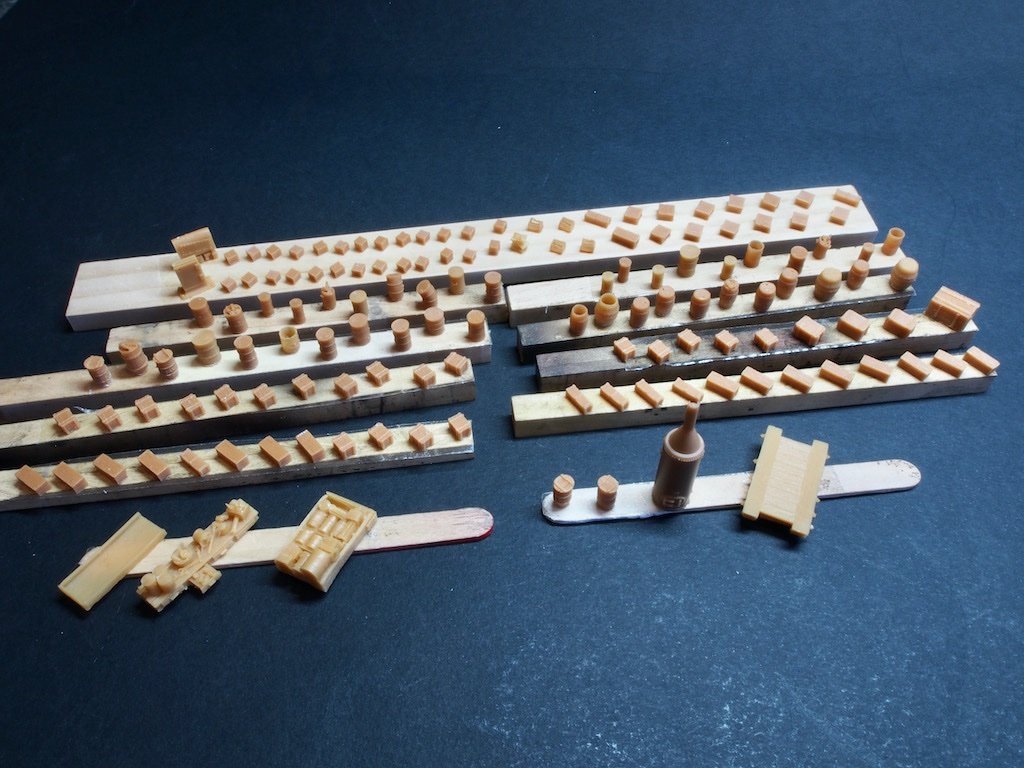
While most of the resin castings are individual parts, there are a couple of composite castings that pack in an incredible amount of detail – especially when one remembers the size of these. For reference, the castings in the foreground of the above picture are mounted on popsicle sticks. Here is a close-up of the casting of the work bench top (centre casting on the left popsicle stick). Note the open drawer full of “stuff” as well as the clutter on the bench top.
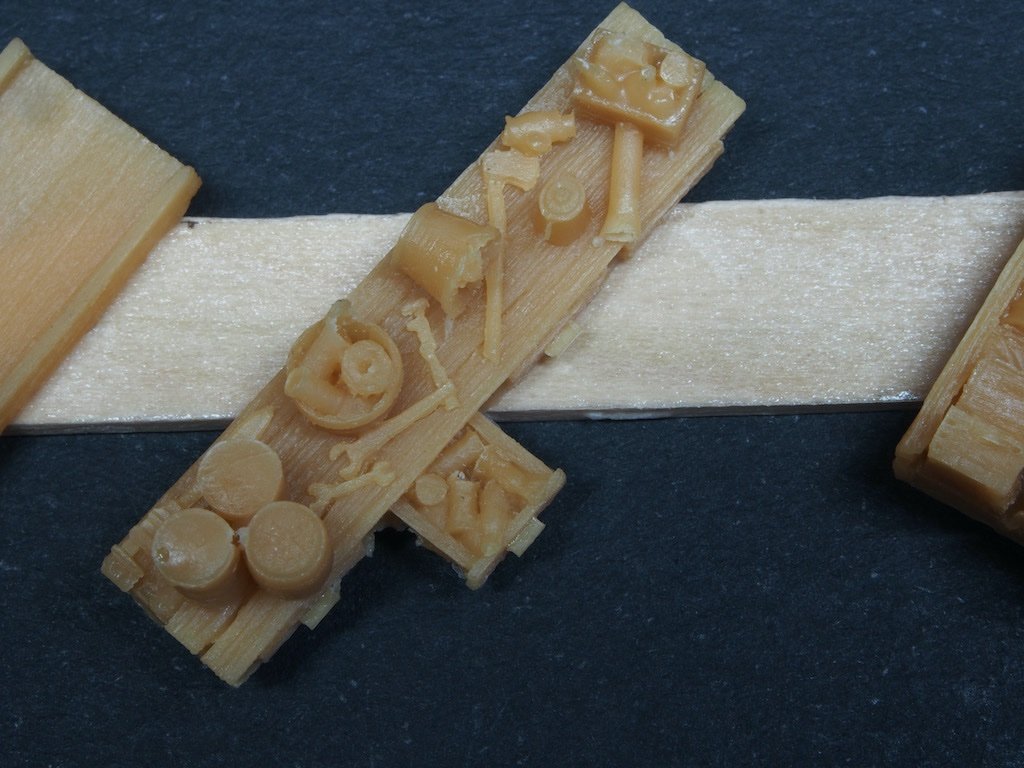
And here is the open cupboard right next to it.
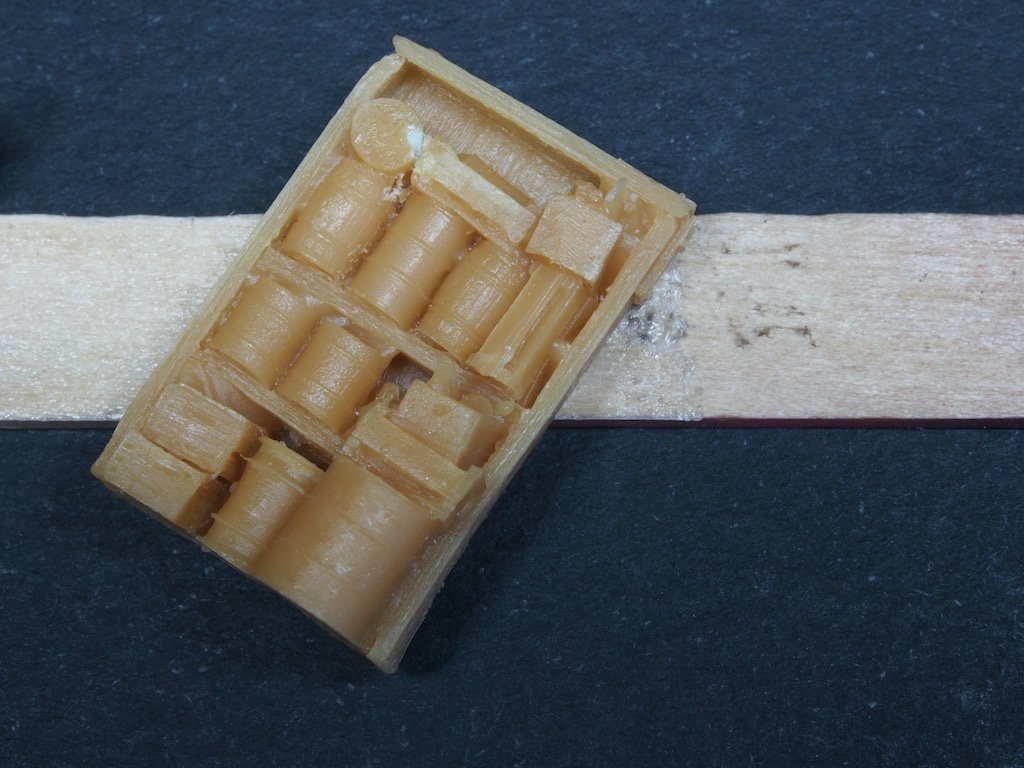
Some of the barrels and bins are also filled with incredibly details parts, like this barrel full of spare/discarded parts.
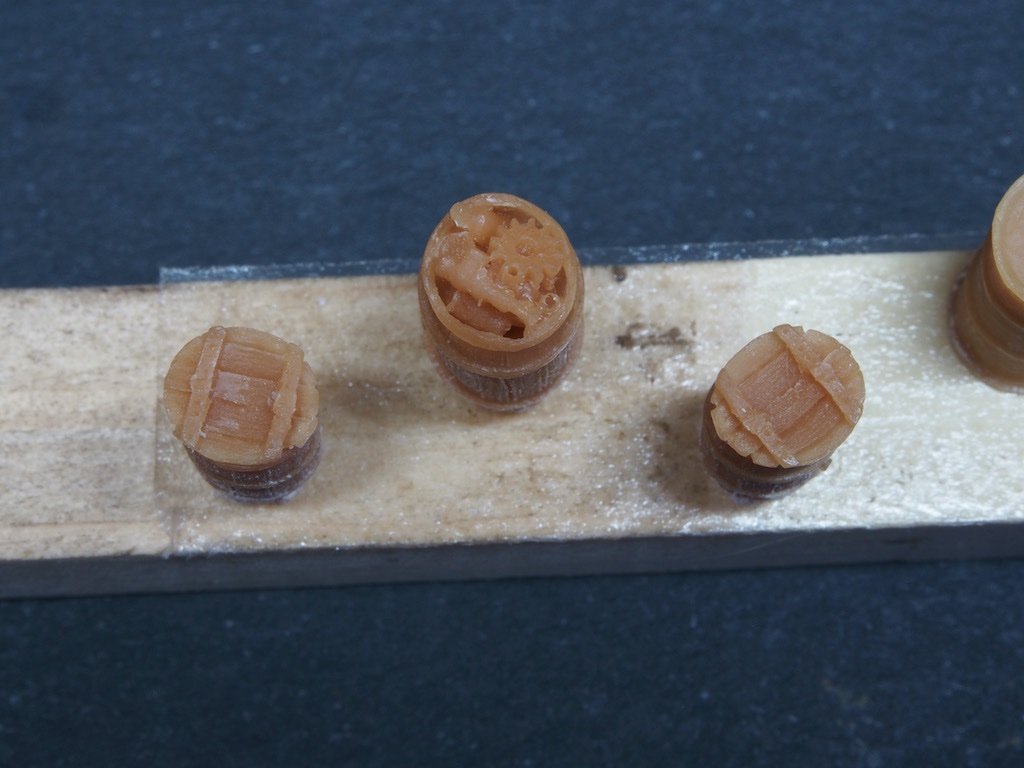
Although some of the tutorials suggest that castings representing metal should be sprayed black and those representing wood should be sprayed a “wood” colour initially, the kit designer in his own tutorial suggest spraying all parts black initially, regardless. I took that advice and sprayed all of these parts with Stynlyrez Black Primer using my airbrush. Another afternoon’s work….
-
Looks like it all worked out in the end Tim, but I don’t know why you shied away from using fibreglass. I too was terrified when I first used it, but by following the advice I found on another site (RC Groups), I found it was actually quite easy. It might have actually saved you some time/effort. But, all is well that ends well as the saying goes. 🙂
-
Just a thought Keith, but rather than printing across many small sheets and having to stick them together (with inherent risks to accuracy), why not take your PDF to a local plans printing shop and ask them to print on a large format paper? I don’t think the cost would be prohibitive, particularly taking the benefit into consideration.
- Keith Black, mtaylor, Siggi52 and 4 others
-
 7
7
-
Just stumbled across your log here Keith. What a beautiful and interesting subject you have chosen! I’m pulling up a chair and will follow along from here.
- mtaylor, KeithAug, Keith Black and 1 other
-
 4
4
-
A minor update...
The Wooden Fence
As the kit instructions remind us, fences create a barrier that allows us to define a scene. This is a simple board on board construction using the provided template to define the overall dimensions and placement of key components – the posts and rails. The posts are made from 3/64” square stripwood, and the rails from 0.020” x 1/16” strips. Individual boards of 0.02” x 3/32” are then applied after applying plenty of texture, splits and cracks. I forgot to take any in-progress photos, but here are a couple of completed shots.
Overall view.
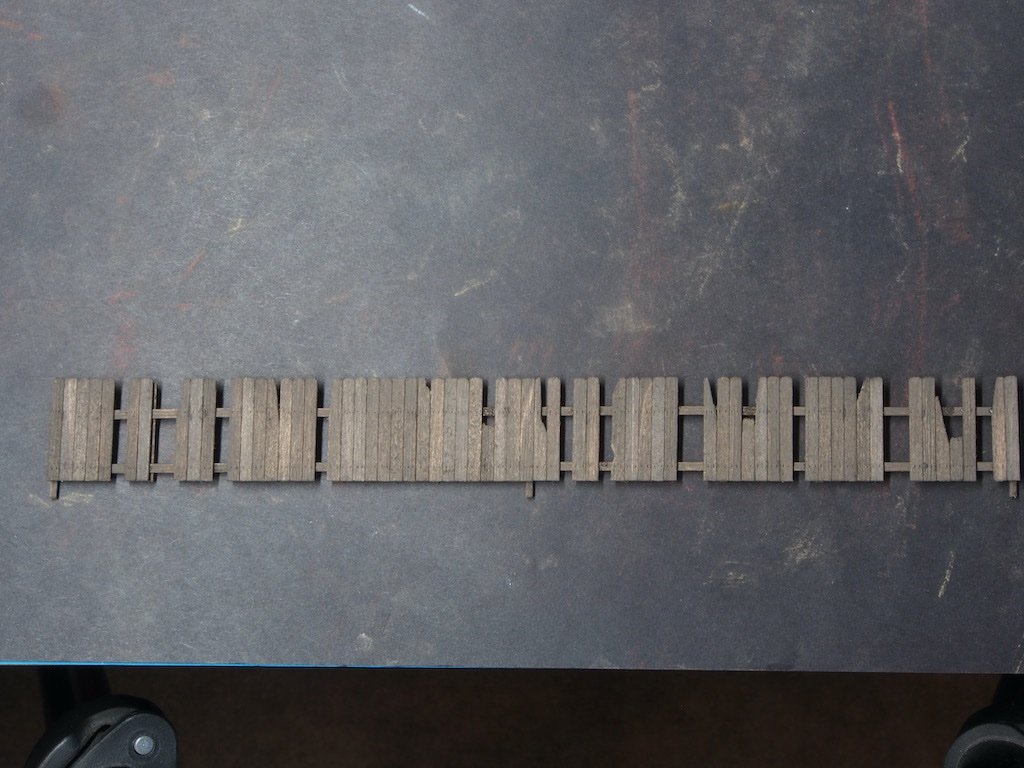
And a close-up of the mid-section.
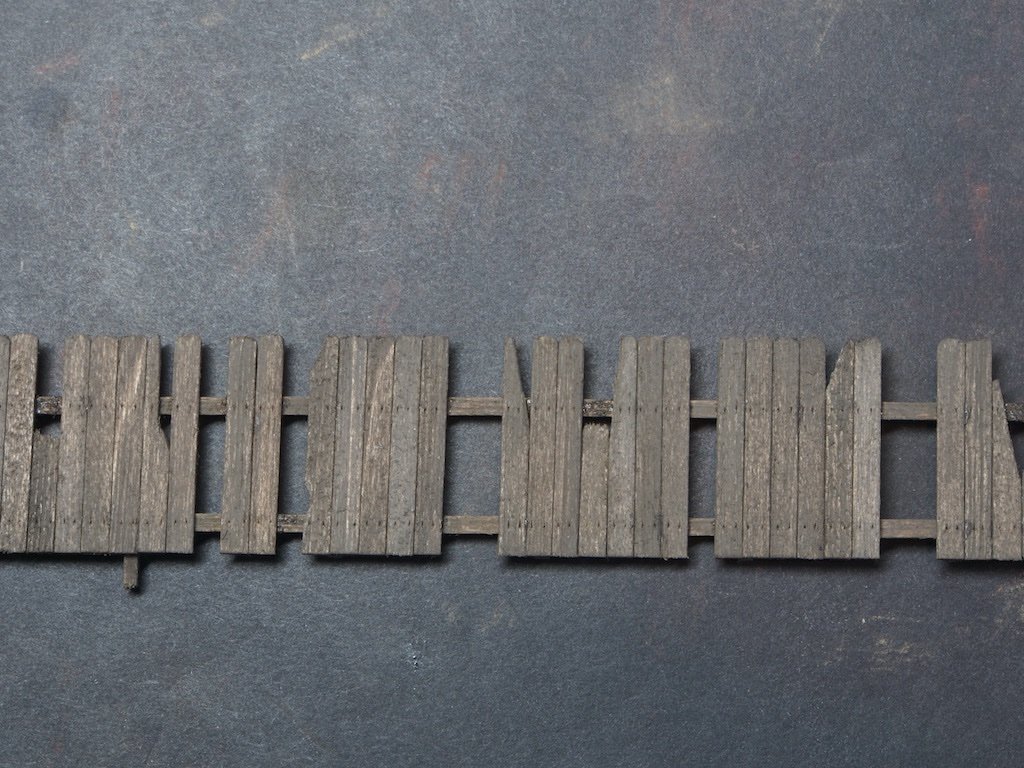
The fence is now set aside for later placement on the diorama.
The Bumper Pilings
The bumper pilings are made from dowels. Unfortunately, there did not seem to be enough dowel of the right diameter (3/16”) provided in the kit to complete this task, so I supplemented the kit stock with some from my own stash. The latter were slightly larger in diameter and of a much harder wood. The harder wood made imparting grain much harder, and for this I used the edge of a saw blade for an exacto knife. Tyres are provided in the form of white metal castings which are blackened, buffed, painted and chalked before being attached. I did not like the look of the provided cotton string, and there was not enough for the task anyway, so again I substituted from my own stash for this. Again, I did not take any in-progress shots, so here are a few of the completed pilings. I tried to follow as closely as possible the distribution/layout shown in the example in the instruction manual, including deliberately leaning some of them.
The main dock pilings.
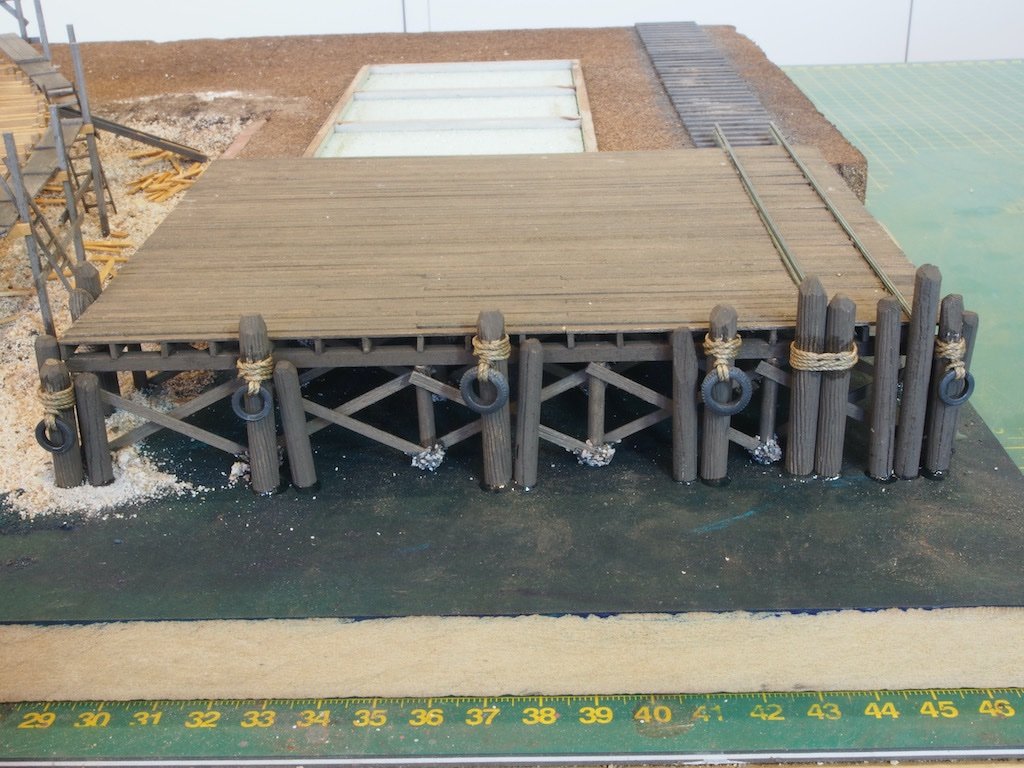
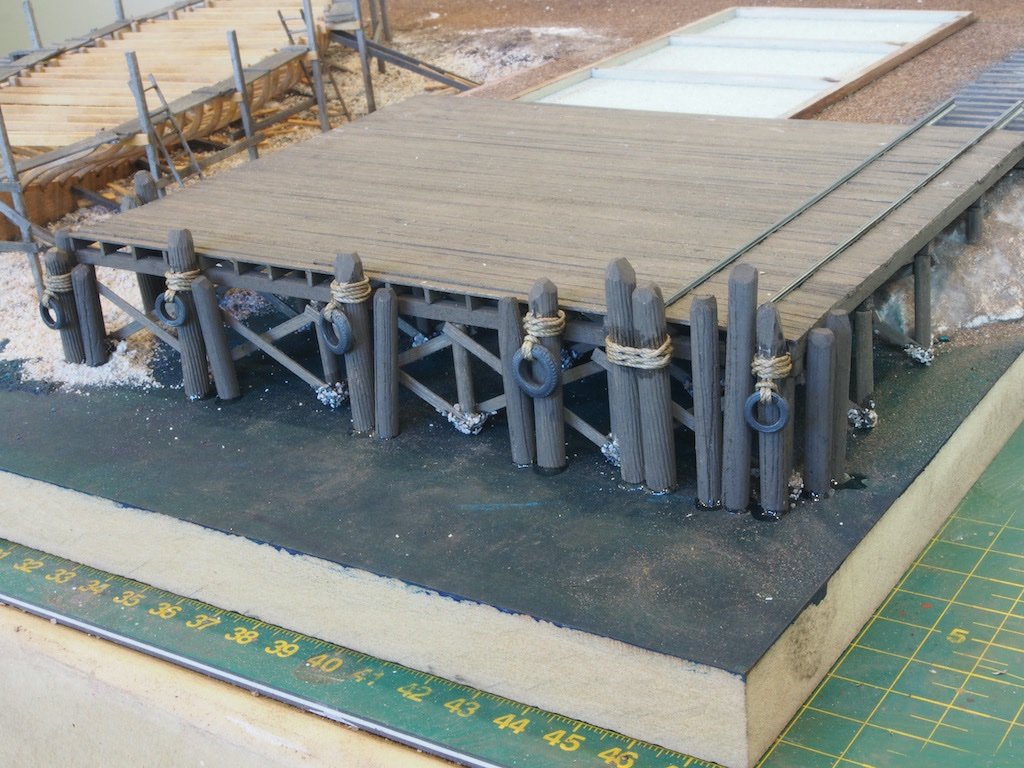
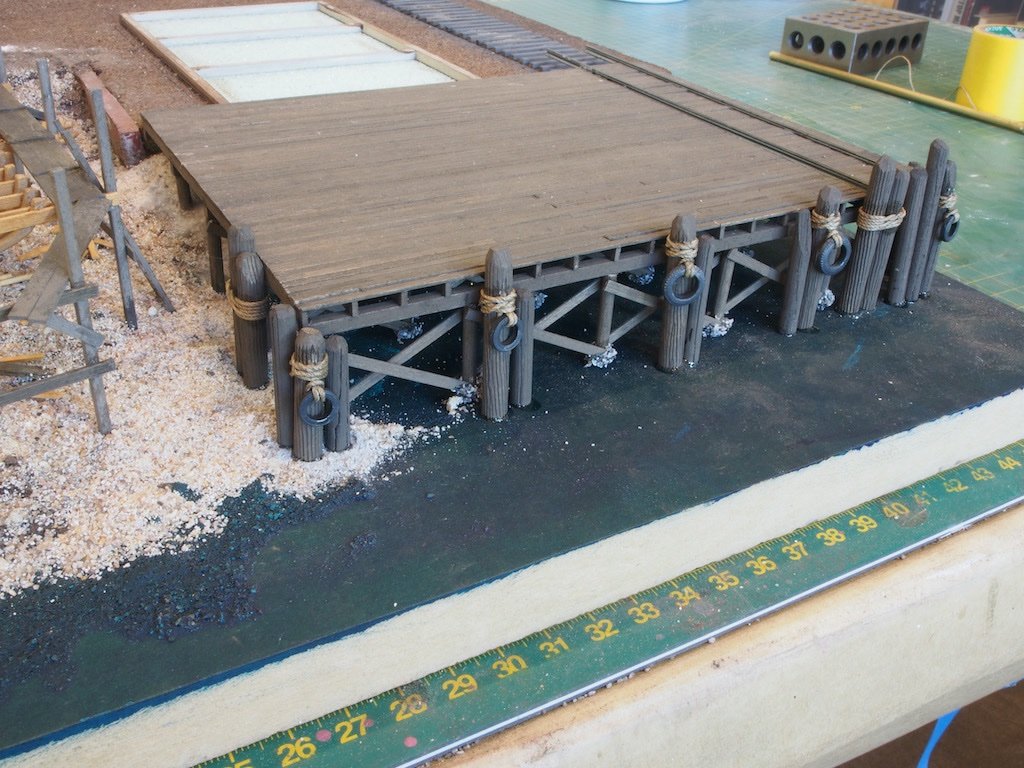
And the Barge Derrick Dock.
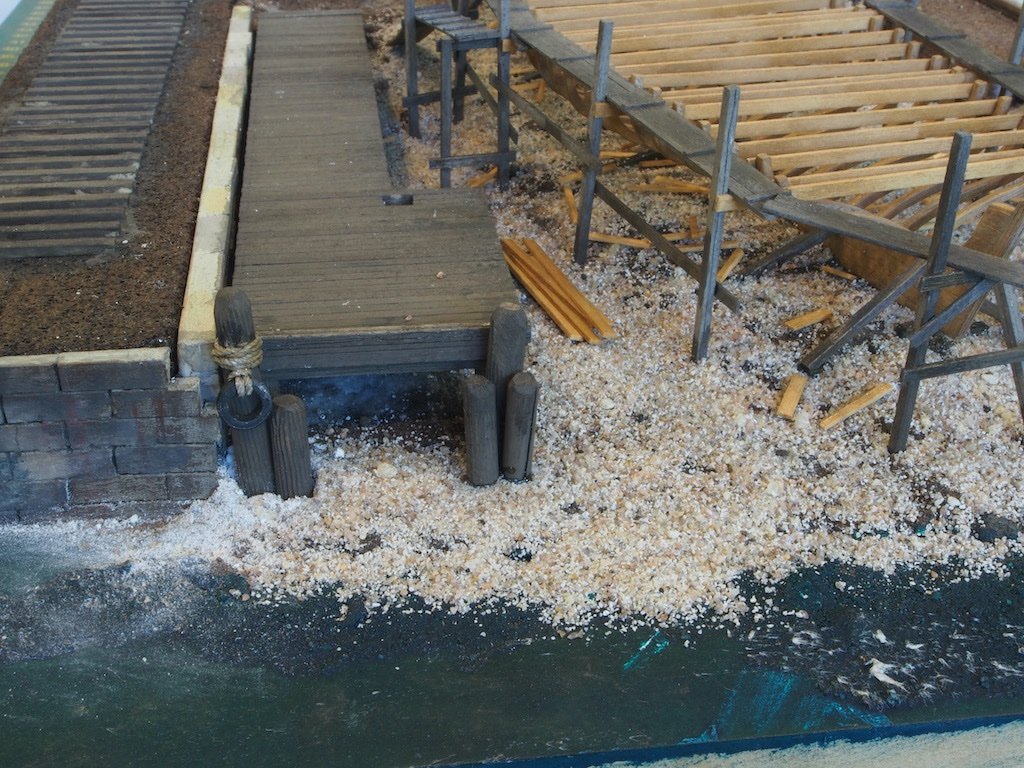
The Steam Box
The steam box was used for softening the planking, making it easier to bend to attach to the hull. Steam from the boiler was pumped into the steam box and a little while later, it was ready to go. This provides an excellent opportunity for creating a scene that tells a story within a story.
The actual construction of the steam box is very straight forward with a solid core of ¼” square stock being clad in some .020” x 3/32” stripwood and 0.020” x 1/16” stripwood. Wrap braces are made from more of the 0.020” x 1/16” stripwood and applied. Finally, the legs and braces are made up from 3/64” square strips for the legs and 0.020” x 3/32” strips for the braces. Thin paper strips are used to create the hinges on the doors and a small white metal cast hose ring / inlet is blackened and buffed before being epoxied in place. Again, no in-progress shots, but here is the completed Steam Box – 3 ½” in overall length.
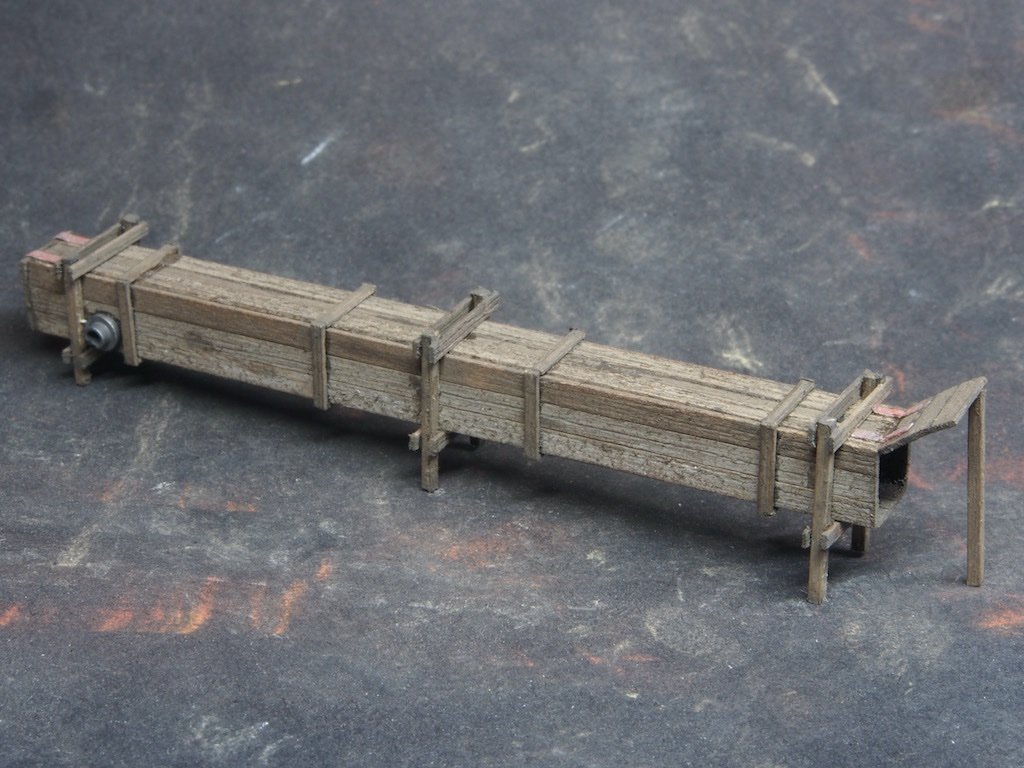
Next up will be the boiler to accompany the Steam Box.
- popeye2sea, BobG, realworkingsailor and 17 others
-
 15
15
-
 5
5
-
Thanks for that excellent explanation Elmer - that all makes perfect sense to me. 🙂
-
The chain is to prevent the presumably removable through-pin from working its way out. I do agree though that there might be more rigging/support required - especially if the mast is able to rotate (which I think it must do).
-
The jib is held to the mast by a through-pin. In this case, the modelling simplification is to use two short pins instead of one through-pin. Other than that, I can’t say - it’s just the way the kit is designed.
-
Thanks Glen and also once again for of the "likes".
The Barge Derrick
At first glance through the instructions, the Barge Derrick would appear to be a fairly simple construction. However, it proved to be a quite challenging element of the overall kit. The barge derrick is made up of a number of wooden parts and quite a few cast white metal parts – some of the latter being both tiny and rather fragile.
First up, we gather the pre-cut wooden components – the mast, jib, the laser cut wooden block components, and a couple of wood strips – and grain and stain them after imparting a slight taper to the outer ends of both mast and jib.
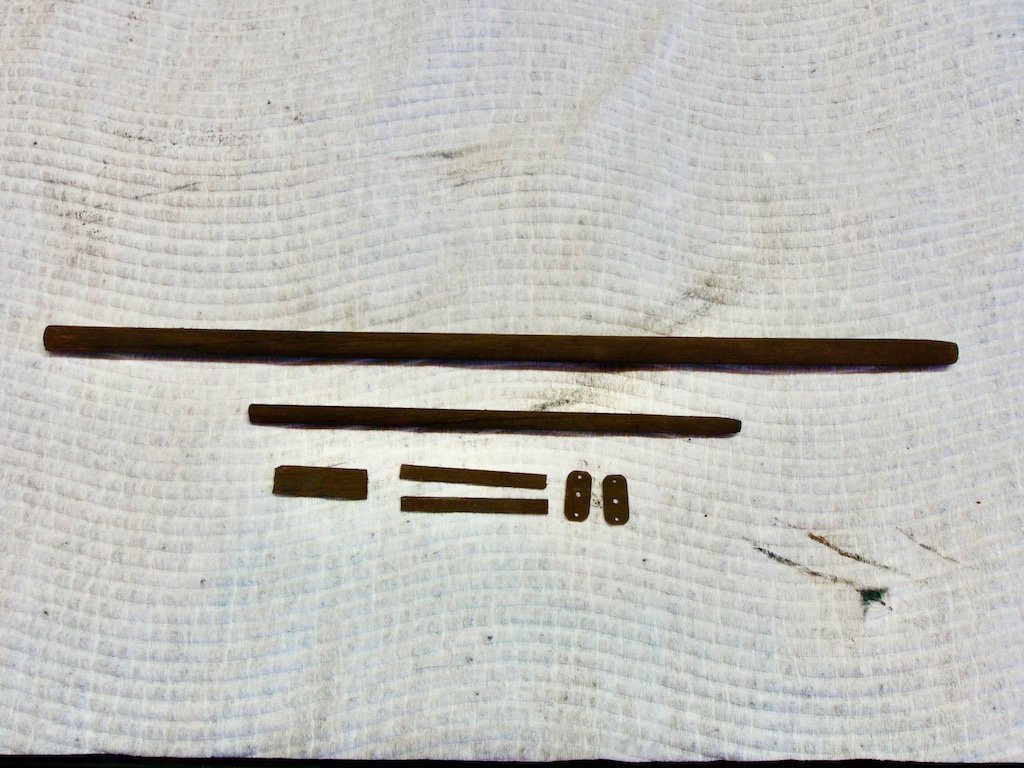
Next, we search through the dozens of tiny white metal castings to identify and extract the ones we need for this assembly. These are then cleaned and chemically blackened. These include the bearings (x2), pillow blocks (x2), gear wheel, pinion, cleat, pulley wheels (x3), crank, hook, clevises (x5) (I would call these shackles), eyelets (x4), length of chain, and 1/32” diam brass rod. In the picture below, I have included the tips of my tweezers on the right-hand side as an indicator of scale. The very first issue I had was losing the tiny pinion gear while cleaning the parts – it pinged off the end of the tweezers and fell straight through the hole in the space-time continuum, never to be seen again. This was unfortunate, as this particular piece was a unique shape. Luckily, I was able to substitute a very similar piece from the additional castings and only the kit designer will ever know the difference!
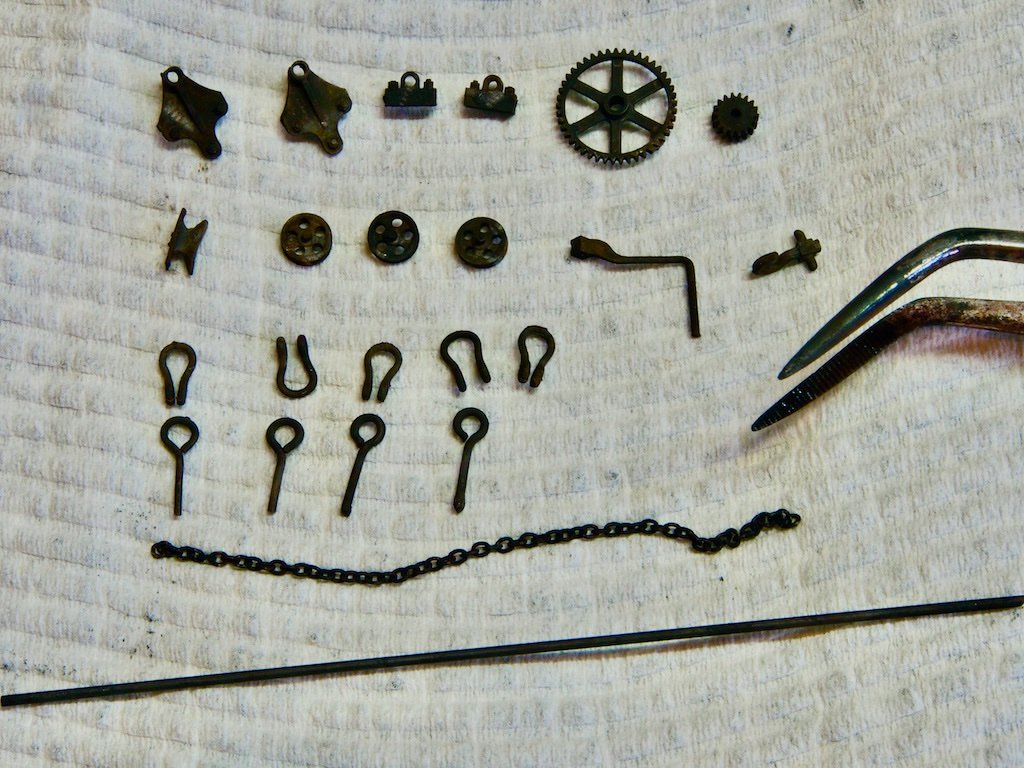
Next, we are instructed to lay a piece of masking tape on the bench and colour it with a little Polly Earth (I used AK 11008, Grimy Grey) and some brown chalk powder. A thin strip about 1/16” x 1 1 /2” is then cut off – we need a few of these, so they were all made at once.
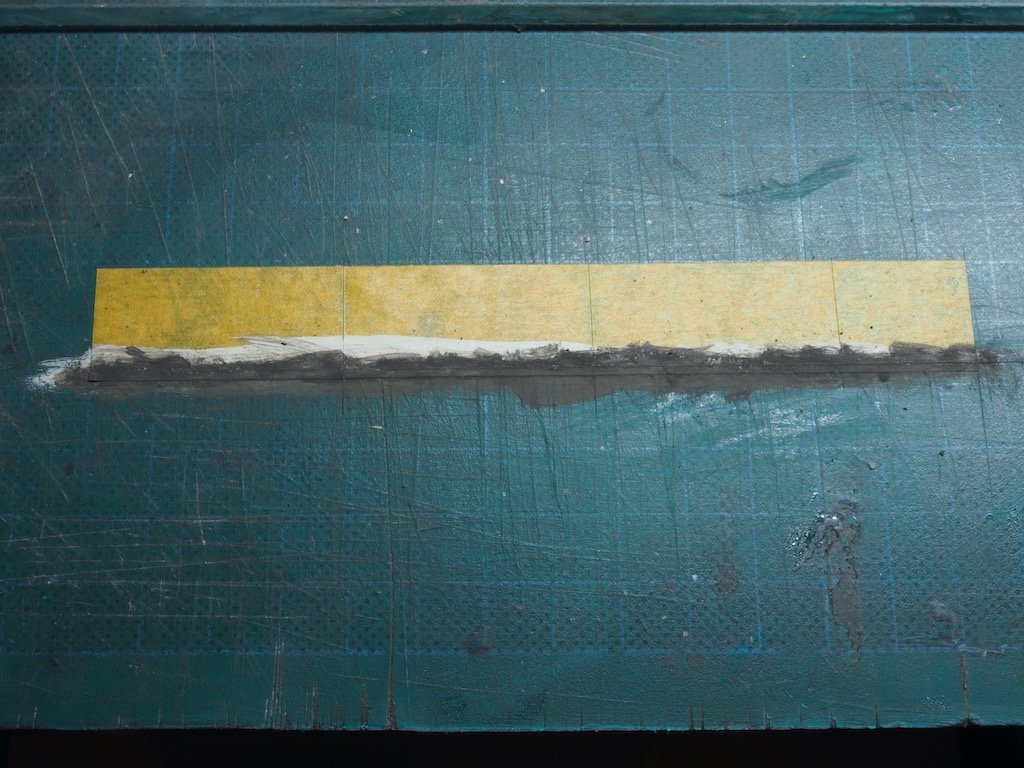
I diverted from the sequence in the instructions a little from here on, just to keep the workflow going. The next step was to wrap the tape around the top end of the mast and then drill a hole for an eyelet to be epoxied in place. Two more strips and three eyelets are also added to the outboard end of the jib. One of the pulley wheels is epoxied to the inside of one half of the laser cut block and once dry, the other half of the block is epoxied in place and two very short brass pins are cut from the length of rod and inserted through the holes in the end of the block.
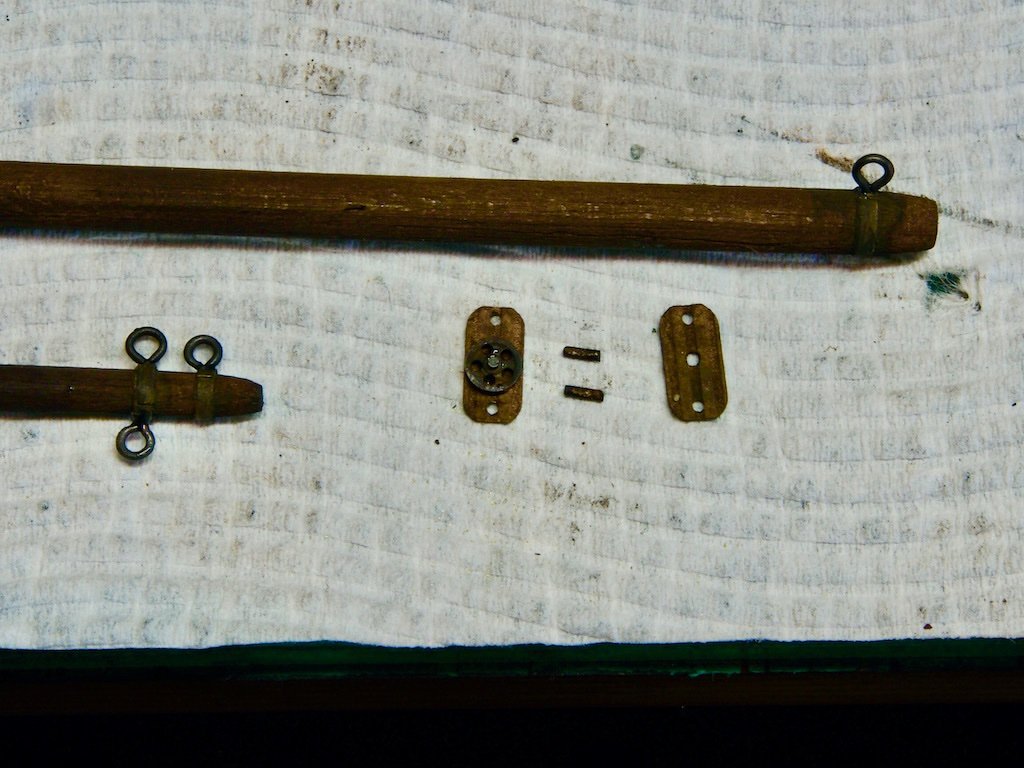
Two wood strips, each about 1” long are then attached to the inboard end of the jib, with about half their length overhanging the jib end. Once dry, we are instructed to wrap these strips with the provided waxed thread for about ¾ of their length, leaving about ¼” of the strips exposed. These are what is used to attach the jib to the mast. This is where I ran into two problems. Firstly, the length of thread provided in the kit is insufficient to wrap the length directed. This was no big deal – I have a sizeable stash of high-quality (Syren) rigging thread for my ship modelling, so it was easy to find some of the same thickness, run it through some wax and proceed. The slightly bigger issue is that if the wood strips are wrapped too far, they will not expand far enough to fit around the diameter of the mast (which is thicker than the jib) – in fact, it snapped the wood strips on my first attempt. Again not a huge deal – I simply replaced the two wood strips and this time wrapped them in thread only as far as the end of the jib. I used a little CA to secure the wrapped thread at this point and left a long ‘tail’ hanging until after the jib was secured to the mast. The provided template was used to position the jib and set the correct angle. It was epoxied in place to the mast and left overnight to fully cure before completing the wrapping with the thread.
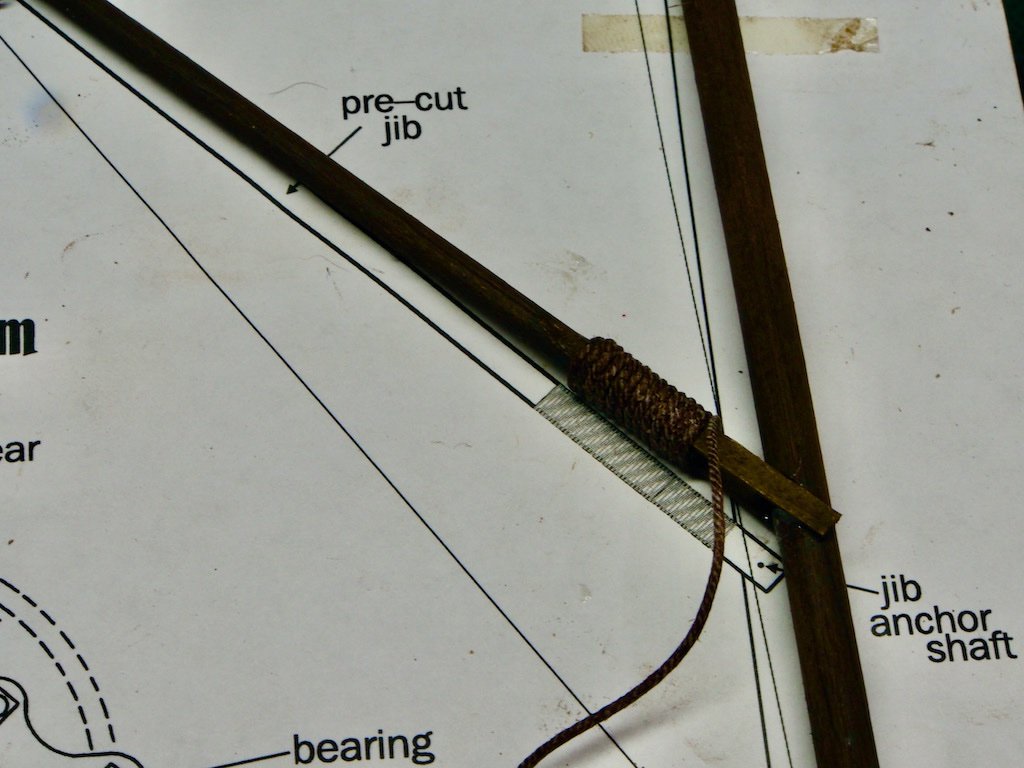
Once cured, two holes were drilled through the wooden strips and into the mast and short brass pins were epoxied in place to accept the preventer chain. Here I ran into another issue. The links in the provided chain are too small to fit over the brass pins. Although the instructions advise us to use the ends of our tweezers to force the link open sufficiently, I was unable to achieve this. No drama – back into the ship modelling stash and after a quick rummage, came up with a length of chain with ever so slightly larger links. Problem solved.
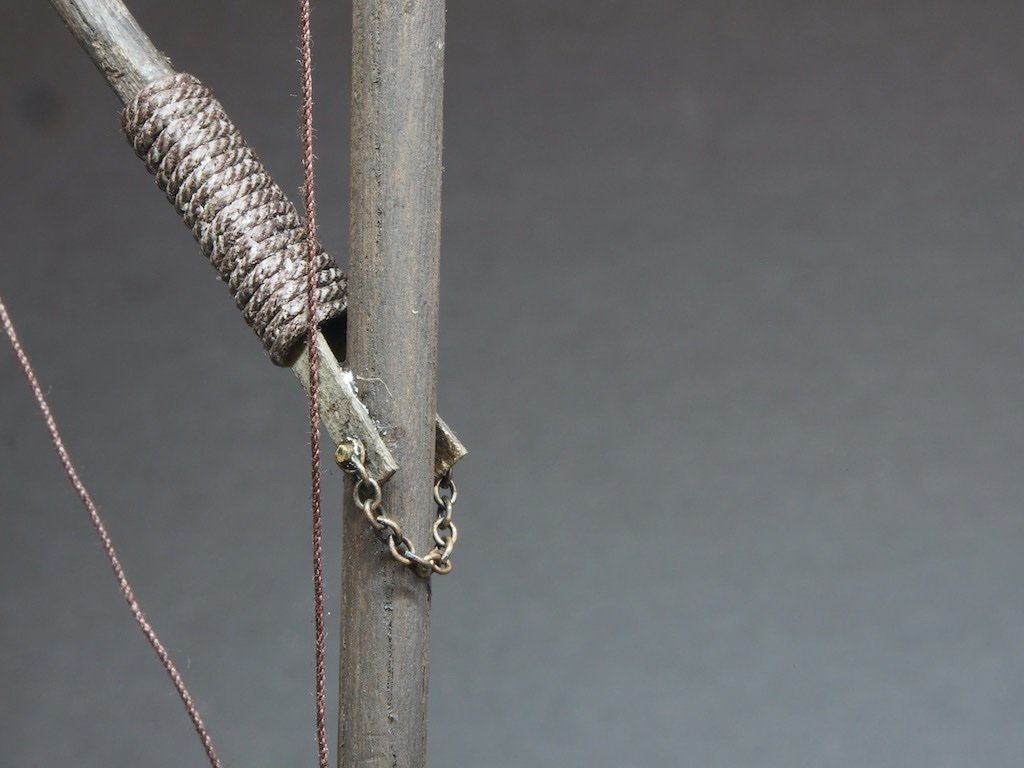
The next issue I encountered around this time was the softness of the white metal castings – specifically the clevises/shackles. The first thing needed to be done with these is to use a drill bit or reamer to open the holes sufficiently to take the axle pins of the pulley wheels, or the brass rod (both are 1/32” in diameter). I managed to destroy two of the five in the process. I was able to find one more of the same size among the myriad of castings, and also found two that were slightly larger, so used one of these as a replacement also.
Two clevises/shackles are attached to either end of the large wooden block. The photo makes the block look grey but it is in fact brown, as is the mast itself - i just had to adjust some settings while editing the photos to make the parts more visible.
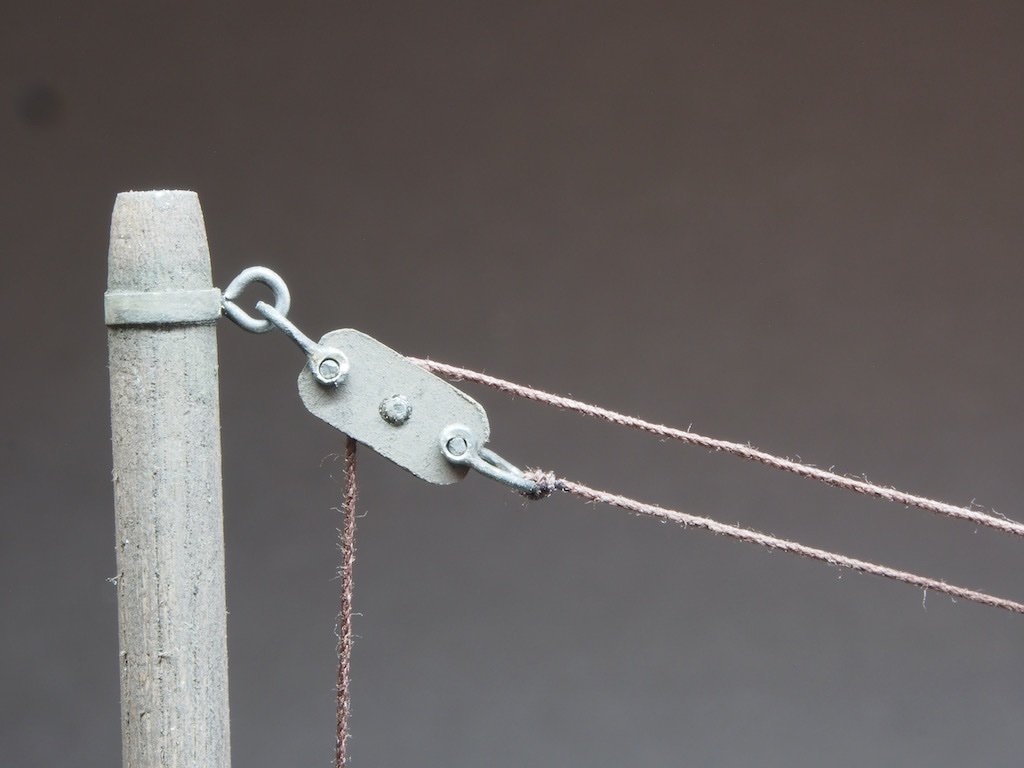
Two more are used to attach the pulley wheels to the eyelets previously installed.

The larger replacement clevis/shackle was used to attach the hook. The rigging thread also gets some tape wrapped around it just above the hook.

The bearings, gear, pillow blocks, pinion and crank are then epoxied in place at the base of the mast. This was quite a slow process as it was necessary to wait for the epoxy to dry on one component before adding the next. However, they were all placed without incident. The rigging line from the hook was also wound around the shaft of the gear wheel.
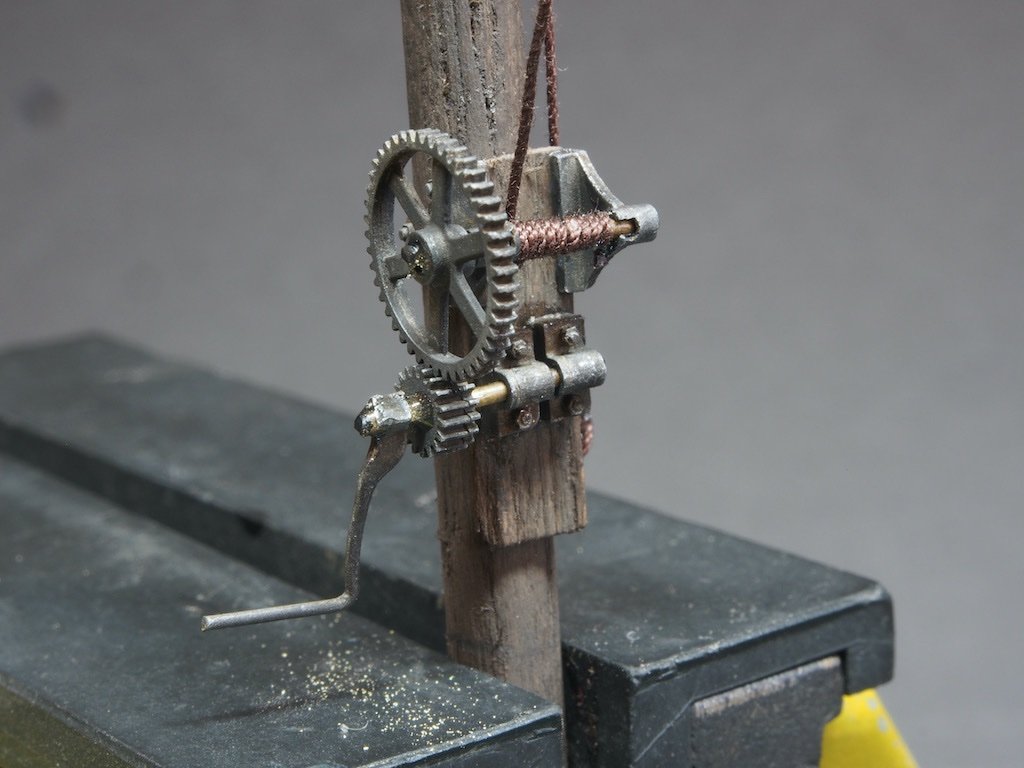
And a view from the other side showing where the rigging line from the jib end is secured to the cleat at the base of the mast. I will add a small coil of extra line to the cleat once the derrick is finally placed on the diorama.
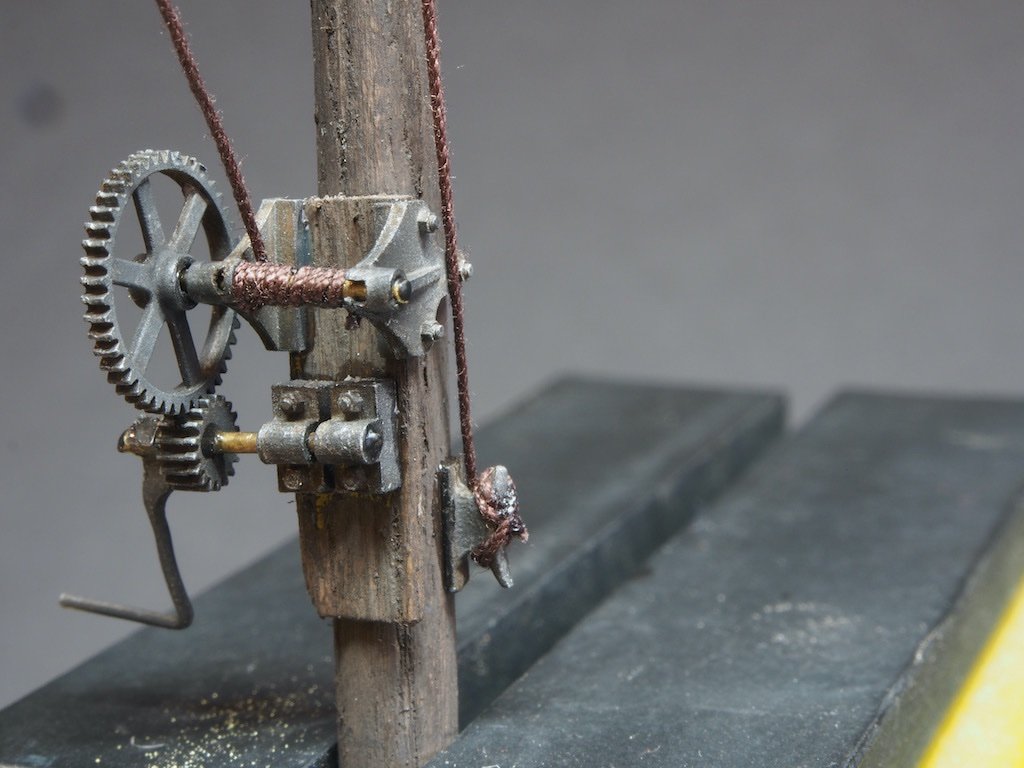
And finally, here are a couple of overall shots of the completed derrick. Note the extra line hanging from the end of the jib. This will be secured to items on the dock once the derrick is finally placed.
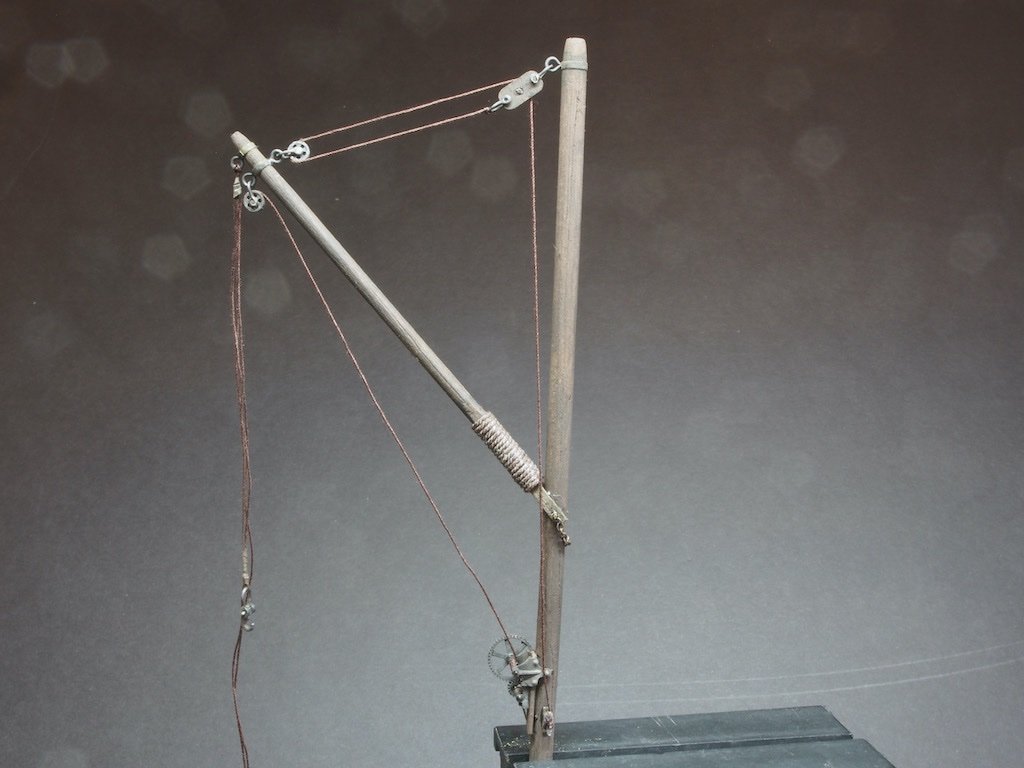
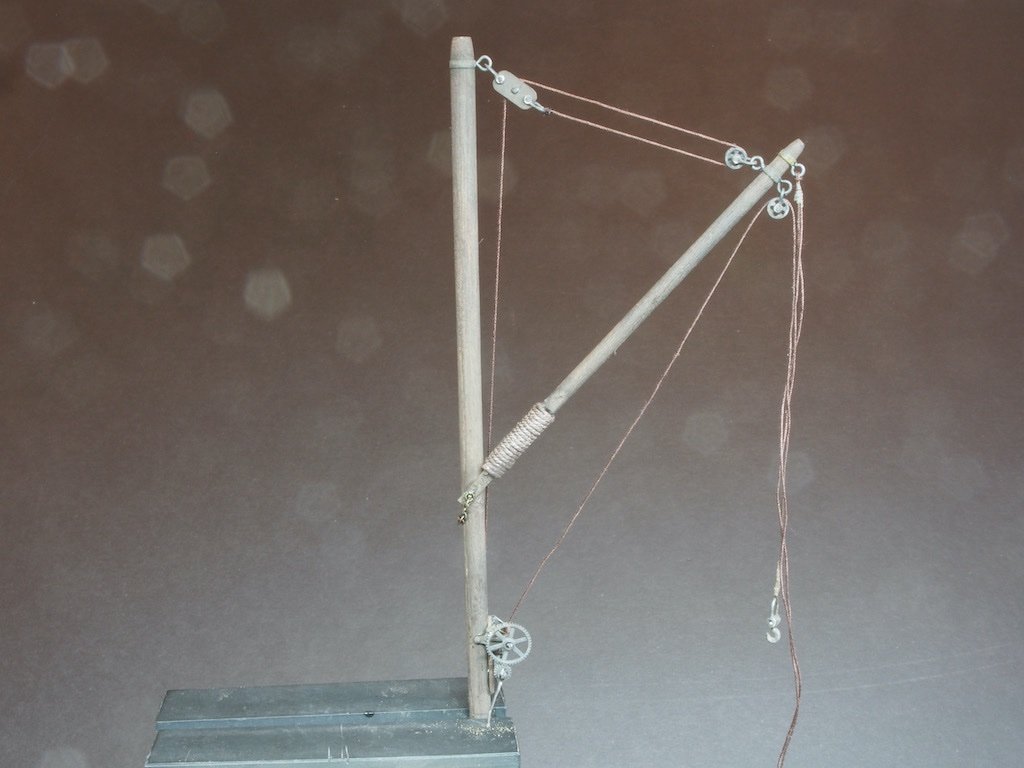
A wooden fence and some bumper pilings are next on the agenda…
-




The Shipyard at Foss' Landing (Diorama) by gjdale (Grant) - FINISHED - SierraWest - Scale 1:87 (HO)
in Non-ship/categorised builds
Posted
Continued from previous post...
A Canvas Rack is built up, once again using the provided template to build directly over.
The two sides are then joined by some cross-braces.
Rolls of canvas are then made by cutting strips of tissue paper 30mm wide by about 250 long and rolling them around a 3/32” diameter piece of brass rod. The ends are secured with some diluted white PVA glue before the rolls are given a coat of diluted off-white paint and a final dusting of some dry chalk powder. Here is the completed canvas rack.
The Oil Drum Rack is built up in a similar fashion.
Here is the rack, ready for it’s occupant.
A previously prepared drum is then added together with a hose made from 1.0 mm diameter solder wire.
A number of “mini scenes” are then created from some of the previously prepared castings and some bits of scrap wood. These will each form part of a larger scene in the final diorama. The extreme close-up of the macro lens shows me that I need to go back and take care of some of the shiny bits of epoxy that are evident here.
I believe I am now ready to start adding the details to the diorama itself…